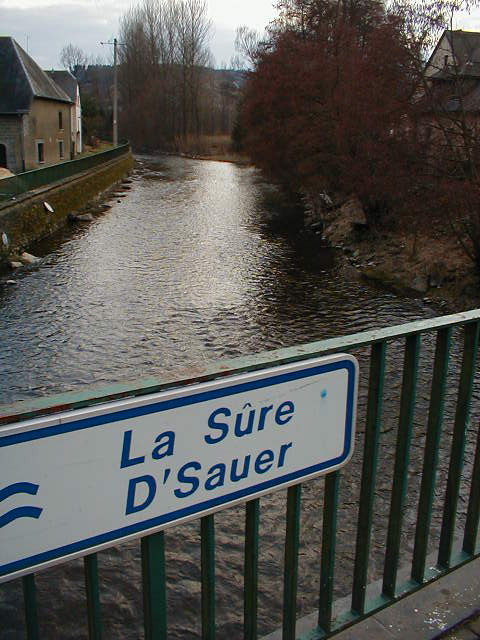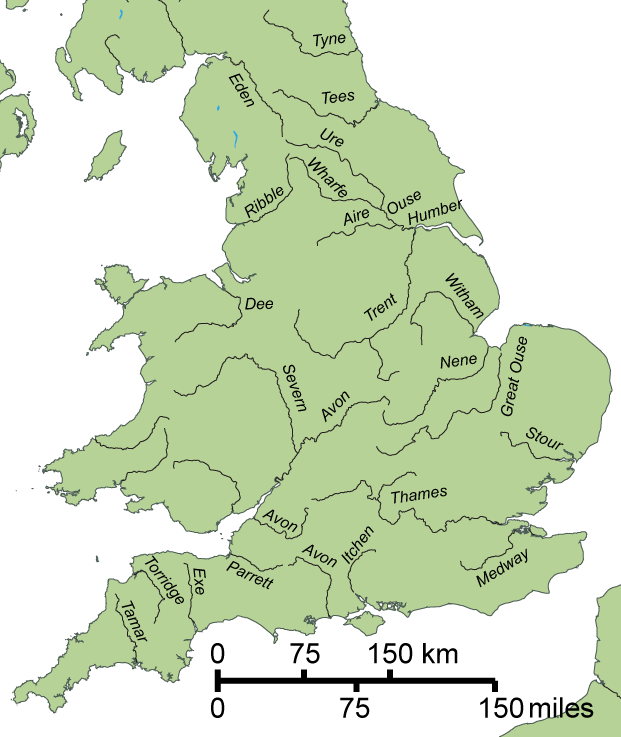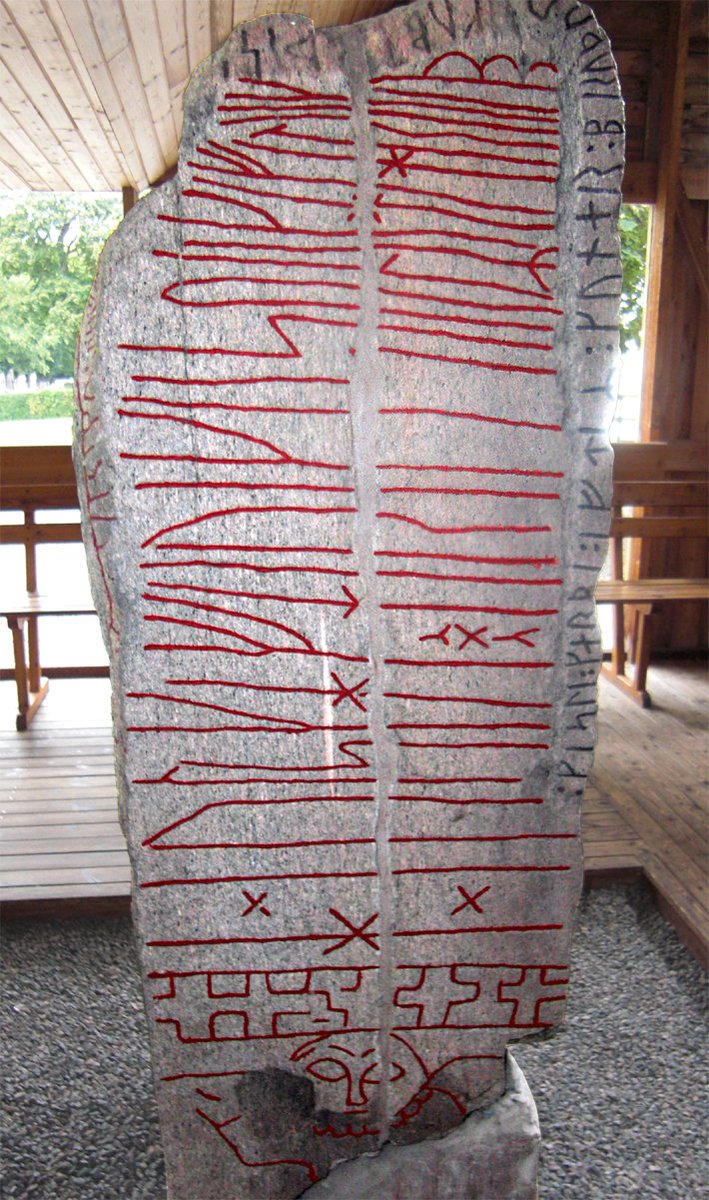Around 3000 BCE in eastern #Europe, a Proto-Balto-Slavic #language started to diverge from #ProtoIndoEuropean.
The #Slavic branch of the #IndoEuropean #languages began about 2,000 years later when Proto-Slavic deviated from Proto-Balto-Slavic.
[Image: commons.wikimedia.org/wiki/File:Balt…]
The #Slavic branch of the #IndoEuropean #languages began about 2,000 years later when Proto-Slavic deviated from Proto-Balto-Slavic.
[Image: commons.wikimedia.org/wiki/File:Balt…]
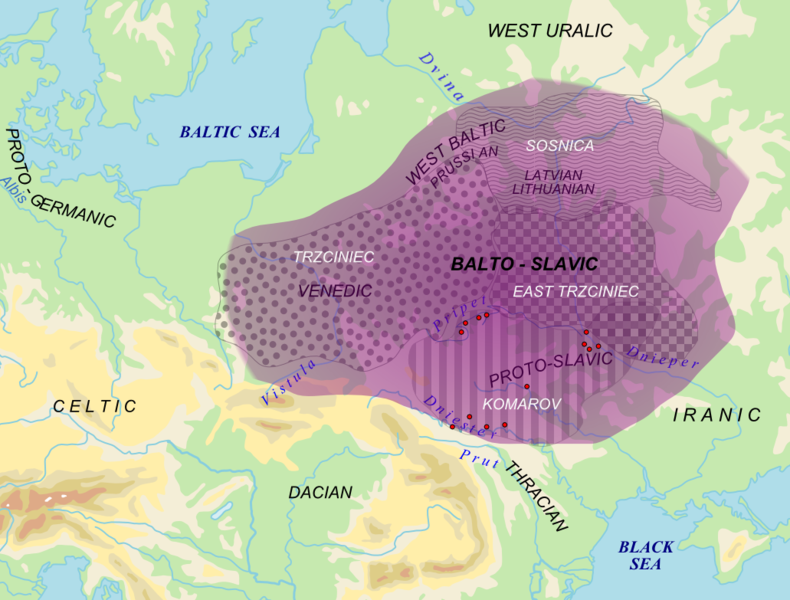
As the #Slavic-speaking area expanded during the first millennium CE (striped area on map), Proto-Slavic transitioned to Common Slavic. The #language underwent minor changes that occurred mostly uniformly across eastern #Europe, thereby maintaining mutual intelligibility. 

Around the year 1000 CE #CommonSlavic began to split into the South, West, and East branches to which all modern #Slavic #languages belong.
Roughly 315m people speak a Slavic #language, mostly in Eastern #Europe (including the #Balkan peninsula), #CentralAsia, and #Siberia.
Roughly 315m people speak a Slavic #language, mostly in Eastern #Europe (including the #Balkan peninsula), #CentralAsia, and #Siberia.

The first recorded #Slavic names and words appear in 6th-century #Greek-#language documents from the #Byzantine Empire. They describe two Slavic tribes, the Antes and the #Sclaveni (#Sklavenoi in Greek), who invaded most of the #Balkan peninsula, including present-day #Greece. 

Exposure to Greek injected new loanwords into the #language of the #Slavs, which already included borrowings from other #languages #Slavic tribes had previously encountered.
#Gothic kaupjan → kōpītej (to buy)
#Iranic rāy → rāji (heaven)
#Greek kalýva → koliba (cottage / hut)
#Gothic kaupjan → kōpītej (to buy)
#Iranic rāy → rāji (heaven)
#Greek kalýva → koliba (cottage / hut)

#Greek, in turn, absorbed #Slavic words:
karvalj → karbélin (bread loaf)
#Greece had hundreds of Slavic place names until a 19th-century Hellenisation policy replaced them. For example, the western town of #Dragomesti recovered its pre-Slavic name, #Astakos (Astacus on map).
karvalj → karbélin (bread loaf)
#Greece had hundreds of Slavic place names until a 19th-century Hellenisation policy replaced them. For example, the western town of #Dragomesti recovered its pre-Slavic name, #Astakos (Astacus on map).

Two 9th-century #Byzantine monks, Saints #Cyril and #Methodius, were brothers from #Thessaloniki who evangelised #Slavs.
Cyril invented #Glagolitic, the first #Slavic #alphabet, and used it to standardise a literary form of the Slavic #language now known as Old Church #Slavonic.
Cyril invented #Glagolitic, the first #Slavic #alphabet, and used it to standardise a literary form of the Slavic #language now known as Old Church #Slavonic.
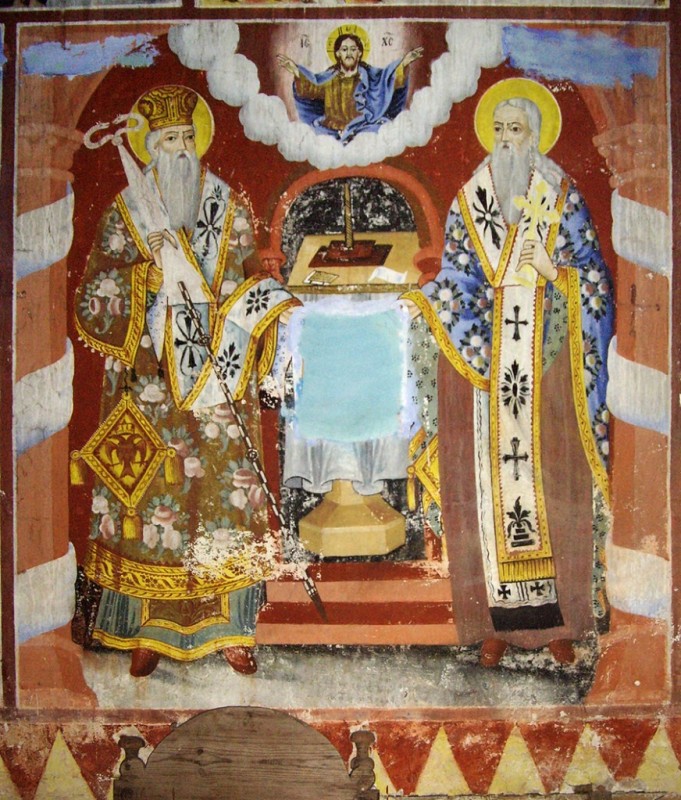
#Cyril created the #Glagolitic #alphabet (around 862/3 CE) because it was difficult to fully represent the sounds of the #Slavic #language using #Greek or #Latin letters. He's believed to have based it on the variety of Slavic spoken around his hometown of #Thessaloniki, #Greece. 

Sources disagree on whether #Cyril was himself Slavic, #Byzantine #Greek — or both. He knew several #languages, including #Slavic, Greek, #Latin, #Hebrew, and #Syriac.
He and #Methodius were the first to #translate the #Bible and other religious texts into #OldChurchSlavonic.
He and #Methodius were the first to #translate the #Bible and other religious texts into #OldChurchSlavonic.

#Cyril and #Methodius's use of #OldChurchSlavonic and the #Glagolitic #alphabet was well-received by the #Slavic population of Great #Moravia, but it created friction with missionaries from the western branch of the Church who insisted that only the #Latin liturgy should be used. 
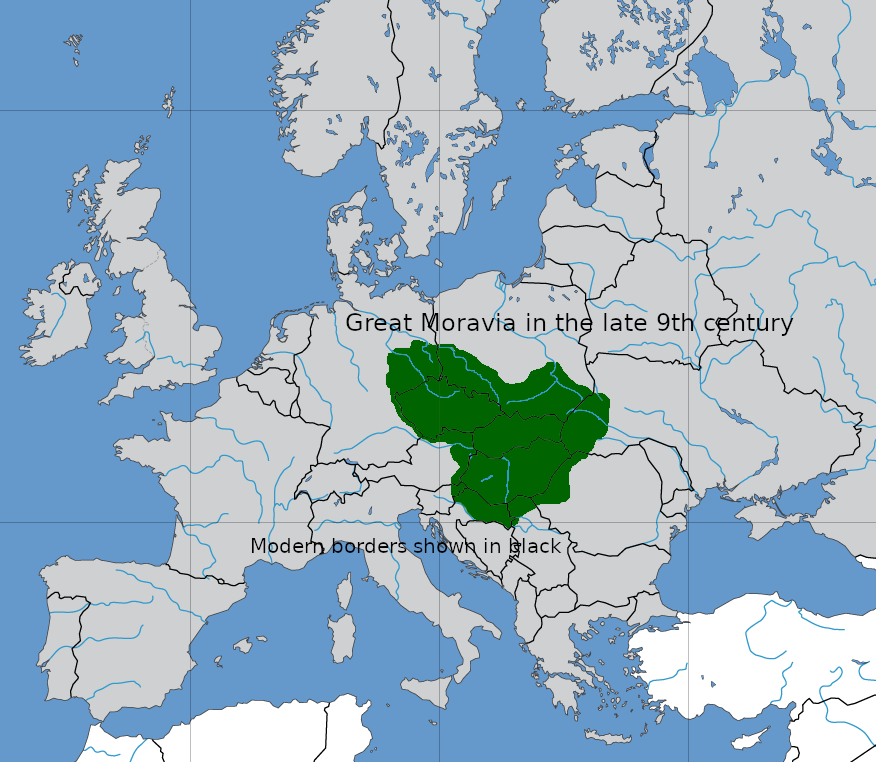
Saint #Cyril died in 869.
In 880 the Bishop of #Nitra (in Great #Moravia) banned the #Glagolitic #alphabet and denounced Cyril and Methodius as heretics for holding Divine Liturgy in #OldChurchSlavonic instead of #Latin. He persecuted #Methodius and his #Byzantine followers.
In 880 the Bishop of #Nitra (in Great #Moravia) banned the #Glagolitic #alphabet and denounced Cyril and Methodius as heretics for holding Divine Liturgy in #OldChurchSlavonic instead of #Latin. He persecuted #Methodius and his #Byzantine followers.

#Methodius and his followers fled to #Bulgaria and were welcomed by its ruler, Boris I, who encouraged them to produce Church #literature in #OldChurchSlavonic (aka Old #Bulgarian) instead of #Greek in order to assert the Bulgarian Church's independence from #Byzantine influence. 

In 885-6 Boris I of Bulgaria established two #literary schools: one in #Pliska (present-day #Bulgaria, moved to nearby #Preslav in 893); and the other in #Ohrid (present-day #NorthMacedonia). These schools became key centres of #Slavic scholarship, #literature, and #translation. 

#SaintNaum of #Preslav and #SaintClement of #Ohrid were notable disciples of #Cyril and #Methodius, and founders of the Preslav and Ohrid #literary schools on the order of Boris I. They were prolific scholars and #translators who produced important works in #OldChurchSlavonic. 

At the Council of #Preslav in 893, Boris I acted to fortify #Bulgaria against #Byzantine influence. #OldChurchSlavonic replaced #Greek as the official #language, and Byzantine clergy were banished in favour of #Bulgarian clerics like Saint #Clement of #Ohrid, who became a bishop. 

At the #CouncilOfPreslav in 893 Boris also moved #Bulgaria's capital from #Pliska to #Preslav and made his son #Simeon tsar.
Until then, Simeon I had been a scholar who #translated religious works from #Greek into #OldChurchSlavonic under the guidance of #Naum of Preslav.
Until then, Simeon I had been a scholar who #translated religious works from #Greek into #OldChurchSlavonic under the guidance of #Naum of Preslav.

As if 893 wasn't momentous enough in the #history of #Slavic #linguistics, it's also the year the #Cyrillic #alphabet became official in #Bulgaria.
Cyrillic would go on to become one of the world's major scripts, used today by #Orthodox #Slavs and several non-Slavic peoples.
Cyrillic would go on to become one of the world's major scripts, used today by #Orthodox #Slavs and several non-Slavic peoples.

Some sources claim that #Simeon I personally commissioned the #Preslav #Literary School to create the #Cyrillic #alphabet.
In fact, it may have originated in some other part of the First #Bulgarian Empire and was then systematised at Preslav.
10th-century sample from Preslav:
In fact, it may have originated in some other part of the First #Bulgarian Empire and was then systematised at Preslav.
10th-century sample from Preslav:

The #Cyrillic #alphabet was not invented by #SaintCyril — it emerged years after his death.
#Mediaeval scholars, possibly #Cyril's former students who later worked at the #Preslav #Literary School, named the new #Bulgarian script 'Cyrillic' in the saint's honour.
#Mediaeval scholars, possibly #Cyril's former students who later worked at the #Preslav #Literary School, named the new #Bulgarian script 'Cyrillic' in the saint's honour.
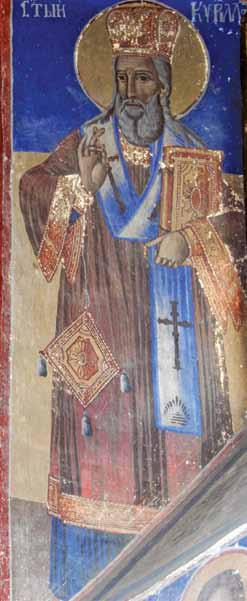
The earliest form of #Cyrillic was written in the '#ustav' style based mostly on #Greek #uncial script #letters. It was augmented by letters and #ligatures (fused-together letters) from the #Glagolitic #alphabet to represent #OldChurchSlavonic sounds not found in Greek. 

The #majuscule (#written all in capital #letters) #uncial style was widely used during the #MiddleAges to #write #Greek, #Latin, and #Gothic. The scribes who created #Cyrillic would have been well acquainted with Greek uncial #writing like this sample from the 8th or 9th century: 

Like their #Greek equivalents, some #Cyrillic #letters had both #phonetic and numeric values.
Ҁ (#koppa) was unusual in that it had the numeric value 90, but no sound value.
Ч (#črĭvĭ) replaced Ҁ as the numeral 90 around the year 1300.
[Image: commons.wikimedia.org/wiki/File:Q_fa…]
Ҁ (#koppa) was unusual in that it had the numeric value 90, but no sound value.
Ч (#črĭvĭ) replaced Ҁ as the numeral 90 around the year 1300.
[Image: commons.wikimedia.org/wiki/File:Q_fa…]

A zigzaggy #titlo (◌҃) over a #Cyrillic #letter denotes a #numeral, as seen on this 17th-century #Russian clock.
'Titlo' derives from a word for 'title', similar to other #superscript #diacritical marks like the #Spanish '#tilde' (˜) and the '#tittle' dot on #lowercase i and j.
'Titlo' derives from a word for 'title', similar to other #superscript #diacritical marks like the #Spanish '#tilde' (˜) and the '#tittle' dot on #lowercase i and j.

One of the earliest works written in the #Cyrillic #alphabet was the #DidacticGospel, most likely compiled around 893 by #ConstantineOfPreslav at the #Preslav #Literary School.
It includes the #AlphabetPrayer, believed to be the first original #poetry in #OldChurchSlavonic.
It includes the #AlphabetPrayer, believed to be the first original #poetry in #OldChurchSlavonic.

In 894 #ConstantineOfPreslav is believed to have written Histories, the first historical chronicle in #Slavic #literature. He went on to write, compile, or #translate numerous other works.
He was an advocate for #OldChurchSlavonic who urged #Bulgarians not to favour #Greek.
He was an advocate for #OldChurchSlavonic who urged #Bulgarians not to favour #Greek.

The #Preslav #Literary School and eastern #Bulgaria in general were quick to adopt the #Cyrllic #alphabet in the 890s.
Writers in the western #Balkans, including at the #Ohrid Literary School, still favoured #Glagolitic, switching to Cyrillic only gradually over a few centuries.
Writers in the western #Balkans, including at the #Ohrid Literary School, still favoured #Glagolitic, switching to Cyrillic only gradually over a few centuries.

The #CodexAssemanius demonstrates that the #Glagolitic #alphabet was still being used to write #OldChurchSlavonic in the 11th century in the western #Balkan area of #Macedonia. The parchment contains Gospel lectures for church celebrations. 

#Bulgarian Orthodox monks from #Ohrid founded the #Zograf Monastery in the late 9th or early 10th century on the #Greek peninsula of #MountAthos on the #Aegean Sea.
Its #library amassed many #mediaeval #Slavic manuscripts written in #Glagolitic and #Cyrillic.
Its #library amassed many #mediaeval #Slavic manuscripts written in #Glagolitic and #Cyrillic.

The #CodexZographensis is an #OldChurchSlavonic manuscript from the late 10th or early 11th century. It was written by #Bulgarian monks at the #Zograf Monastery in #MountAthos, #Greece using the #Slavic #Glagolitic #alphabet. #Cyrillic pages were added during the 13th century. 

The #PsalteriumSinaiticum is an 11th-century #OldChurchSlavonic manuscript written in #Glagolitic. It was discovered in 1850 in another monastery much further south: Saint Catherine's, a #Greek monastery on the #Sinai Peninsula in #Egypt. Where exactly it was written is unknown. 
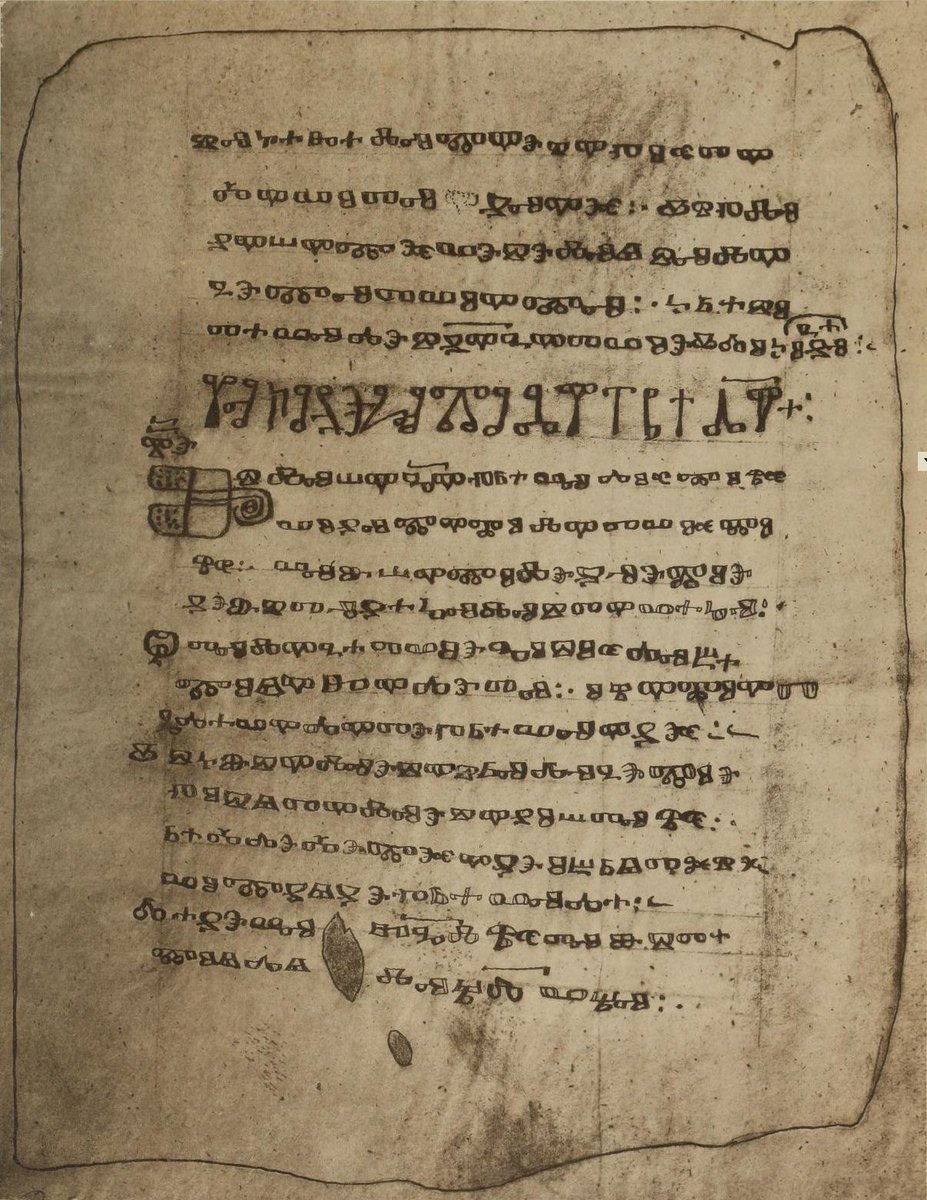
Use of the #Glagolitic #alphabet ended by the 13th century with the notable exception of #Croatia, and the #Croatian Church in particular, which still used the script even into the 20th century.
An inscription in #Zagreb Cathedral created during the #fascist period in the 1940s.
An inscription in #Zagreb Cathedral created during the #fascist period in the 1940s.

Most of the #KievFolios, possibly the oldest #OldChurchSlavonic manuscript, was written in the 10th century, probably in southern #Croatia.
The #Glagolitic document was discovered in the 19th century in #Jerusalem and is now kept at the National Academy of Sciences of #Ukraine.
The #Glagolitic document was discovered in the 19th century in #Jerusalem and is now kept at the National Academy of Sciences of #Ukraine.

The origins of the 11th-century #GlagolitaClozianus is uncertain. Its #OldChurchSlavonic text is written in characteristically #Croatian #Glagolitic letters, but it may be a Croatian copy of an earlier #Macedonian manuscript. 

The #ValunTablet is an 11th-century gravestone found on the island of #Cres in #Croatia. The inscription bears two #languages: #OldChurchSlavonic written in the #Glagolitic script, and #Latin written in the Latin script.
It marked the grave of three generations of a family.
It marked the grave of three generations of a family.

Like the #ValunTablet from #Cres, the #PlominTablet in #Istria also shows the confluence of Romance and #Slavic cultures in #mediaeval #Croatia. An 11th-century #OldChurchSlavonic inscription in #Glagolitic was added to an existing relief of #Silvanus, a #Roman god of the forest. 

Written in #Cyrillic, the #CodexSuprasliensis is the largest known canon manuscript in #OldChurchSlavonic. Its #language follows the norm of the #Preslav #Literary School, where it might have been created in the 10th century, probably based in part on earlier #Glagolitic sources. 

In 972 #Byzantine Emperor John I #Tzimiskes captured and burned #Bulgaria's capital, #Preslav, destroying the #literary school and its trove of early #Slavic #literature, including all of the original works of #ConstantineOfPreslav. (Reproductions kept elsewhere survived.) 

After the east fell, western #Bulgaria resisted #Byzantine conquest for another half century.
Samuel was a #Bulgarian general (and then tsar from 997) who captured most of the #Balkans, including #Duklja, a #Serbian state allied with the #Byzantines, and (below) #Thessaloniki.
Samuel was a #Bulgarian general (and then tsar from 997) who captured most of the #Balkans, including #Duklja, a #Serbian state allied with the #Byzantines, and (below) #Thessaloniki.

Samuel erected this #Cyrillic tombstone in 992/3:
'… I, Samuel, servant of God, made a memory of my father, of my mother and of my brother on these crosses. Here are the names of the dead: Nikolas, servant of God, Ripsimia and David. Written in the year 6501 since Creation …'
'… I, Samuel, servant of God, made a memory of my father, of my mother and of my brother on these crosses. Here are the names of the dead: Nikolas, servant of God, Ripsimia and David. Written in the year 6501 since Creation …'

The tide soon turned against #Bulgaria.
In 1014 #Byzantine Emperor Basil II crushed Samuel's army and captured 15,000. Legend has it he blinded 99 out of every 100, leaving 1 with one eye to lead the others home. Samuel reportedly died of a stroke upon seeing his mutilated army.
In 1014 #Byzantine Emperor Basil II crushed Samuel's army and captured 15,000. Legend has it he blinded 99 out of every 100, leaving 1 with one eye to lead the others home. Samuel reportedly died of a stroke upon seeing his mutilated army.

The #Byzantine Empire fully annexed the First #Bulgarian Empire in 1018.
Greek-speaking clergy tried to replace #OldChurchSlavonic liturgy with #Greek liturgy, but their #Hellenisation effort was only partially successful as the #Slavic #language was by then deeply entrenched.
Greek-speaking clergy tried to replace #OldChurchSlavonic liturgy with #Greek liturgy, but their #Hellenisation effort was only partially successful as the #Slavic #language was by then deeply entrenched.

Sava's book is an 11th-century #Bulgarian manuscript named after an otherwise unknown priest who inscribed his name on two of the folios.
It was written in #OldChurchSlavonic using the #Cyrillic #alphabet, but is believed to have been copied from an earlier #Glagolitic work.
It was written in #OldChurchSlavonic using the #Cyrillic #alphabet, but is believed to have been copied from an earlier #Glagolitic work.

The #EninaApostle is an 11th century #OldChurchSlavonic manuscript discovered in 1960 in a church in #Enina, #Bulgaria.
It was written using the #Cyrillic #alphabet; however, the #Glagolitic letter Ⰱ (buky), which represents the /b/ sound, pops up in a couple of places.
It was written using the #Cyrillic #alphabet; however, the #Glagolitic letter Ⰱ (buky), which represents the /b/ sound, pops up in a couple of places.
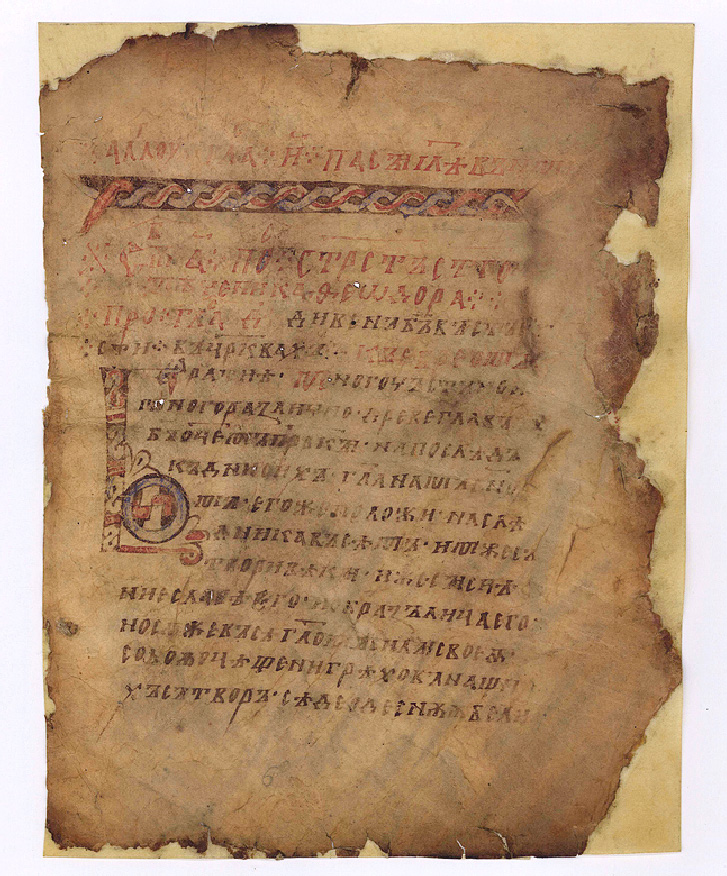
#Bulgaria influenced #literary traditions across the #mediaeval #Slavic world as #OldChurchSlavonic and the #Cyrillic #alphabet spread beyond the #Balkan peninsula.
The Cyrillic #ArkhangelskGospel was written in Old Church #Slavonic in 1092, possibly in #Novogorod, #Russia.
The Cyrillic #ArkhangelskGospel was written in Old Church #Slavonic in 1092, possibly in #Novogorod, #Russia.
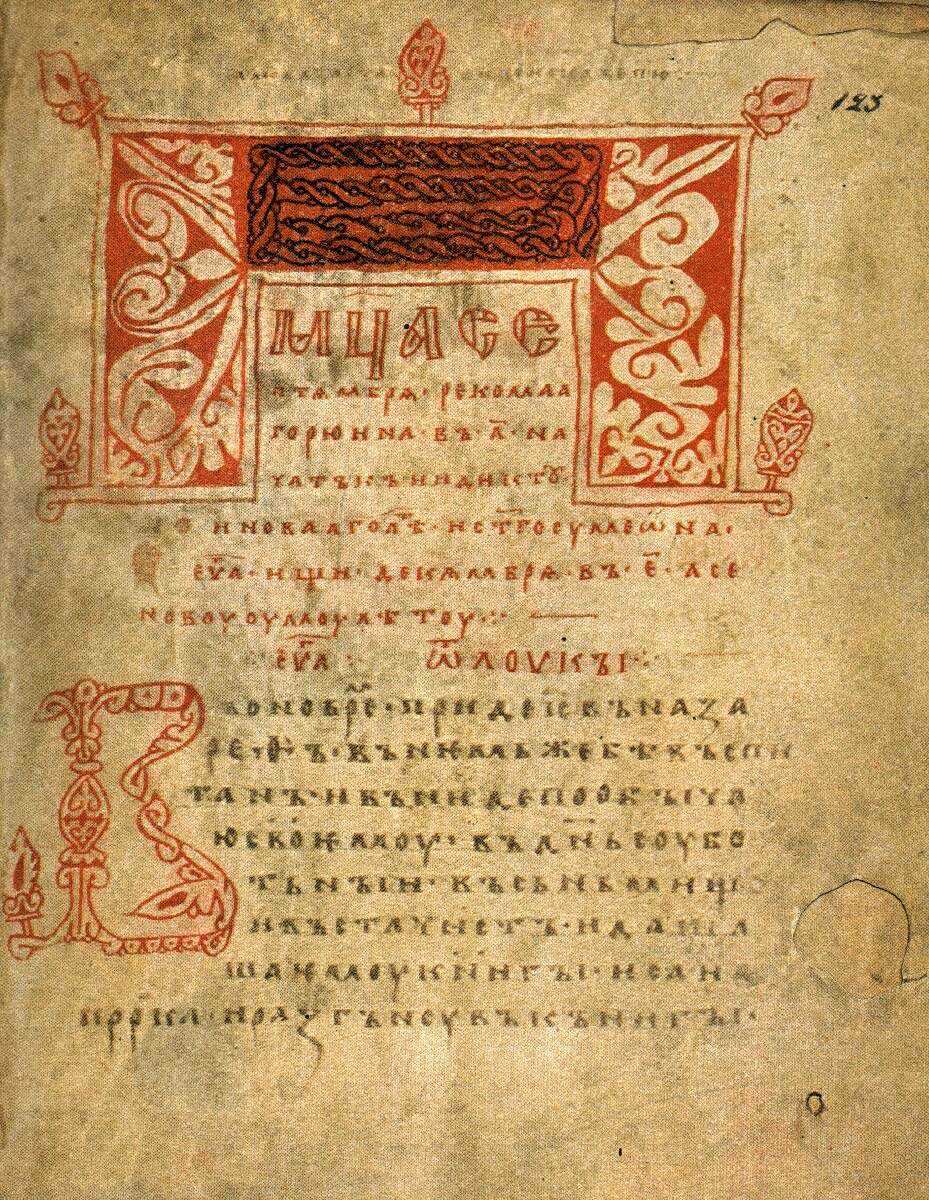
Like the spoken #Slavic #language that gradually divided into local varieties, the formalised #OldChurchSlavonic used by the clergy also fragmented into various 'recensions' beginning around the 12th century, marking the shift from Old Church #Slavonic to #ChurchSlavonic. 

The various #recensions of #ChurchSlavonic (aka New Church #Slavonic) have minor differences in pronunciation. For example, the #Cyrillic letters ѣ, ч, г, and щ are pronounced differently between the #Russian and the western #Ukrainian recensions.
12th-century Russian #Menaion:
12th-century Russian #Menaion:

A more noticeable difference between some #recensions of #ChurchSlavonic is the choice of #alphabet. Orthodox ones use #Cyrillic. The Catholic #Czech and #Croatian recensions use #Latin script. The Croatian one previously used #Glagolitic.
12th-century #Baška tablet, #Croatia:
12th-century #Baška tablet, #Croatia:

The South #Slavic #languages form a #dialect continuum across the #Balkan Peninsula. They have ~30m speakers.
There are two main sub-groups. #Bulgarian and #Macedonian are in the eastern sub-group. #SerboCroatian and #Slovene are in the western sub-group.
There are two main sub-groups. #Bulgarian and #Macedonian are in the eastern sub-group. #SerboCroatian and #Slovene are in the western sub-group.

Around the formation of the Second #Bulgarian Empire in the 12th century, #OldBulgarian (which until then was effectively the same as #OldChurchSlavonic) transitioned to #MiddleBulgarian as it underwent big changes. The #locative, instrumental, and #genitive cases disappeared. 

A #Cyrillic inscription at Asen's Fortress in the #Rhodope Mountains of #Bulgaria. Tsar Ivan Asen II renovated the site in 1231 to fortify the Second #Bulgarian Empire against raids by the #LatinEmpire of #Constantinople, a #Crusader state established during the Fourth Crusade. 

The #Tetraevangelia (Four Gospels) of Tsar Ivan Alexander was created in 1355–1356 at the Second #Bulgarian Empire's #Tarnovo #Literary School. Its 286 parchment folios contain #Cyrillic text written by a monk named Simeon, along with colourful illustrations by a few artists. 

Folio 273v of the #Tetraevangelia of Tsar Ivan Alexander features a unique 25×25 'magic square' of #Cyrillic letters that radiate outward from the centre, spelling the name of the book as 'Io Alexander Tsarya Tetravaggel'. 

Some of the best specimens of #MiddleBulgarian #Cyrillic text are found in the royal charters awarded to monasteries in the Second #Bulgarian Empire.
Tsar Ivan #Shishman issued the #Vitosha Charter to the #Dragalevtsi Monastery south of #Sofia between 1371 and 1385.
Tsar Ivan #Shishman issued the #Vitosha Charter to the #Dragalevtsi Monastery south of #Sofia between 1371 and 1385.

Defeat at the Battle of #Nicopolis in 1396 brought an end to the Second #Bulgarian Empire. The victorious #Ottoman Empire ruled #Bulgaria for nearly five centuries (1396–1878), resulting in reduced status for the #Bulgarian #language and changes to its #vocabulary. 

During the #Ottoman period #Bulgarian absorbed #Turkish words, including some that were borrowings from #Arabic or #Persian into Turkish.
Turkish قالای (kalay) → калай (tin)
Persian کار (kâr, “work”) → кяр (profit)
Arabic قَصَّاب (qaṣṣāb) → касапин (butcher)
Turkish قالای (kalay) → калай (tin)
Persian کار (kâr, “work”) → кяр (profit)
Arabic قَصَّاب (qaṣṣāb) → касапин (butcher)

The #Ottomans merged the Bulgarian Church into the Ecumenical Patriarchate in #Constantinople.
#Greek clergy leapt at the chance to suppress #Slavic culture. They destroyed ancient #Bulgarian manuscripts and imposed Greek liturgy, Greek schools, and Greek books on #Bulgarians.
#Greek clergy leapt at the chance to suppress #Slavic culture. They destroyed ancient #Bulgarian manuscripts and imposed Greek liturgy, Greek schools, and Greek books on #Bulgarians.

The #AlexandriaCodex of #Sofia is a 15th-century #MiddleBulgarian transcription of the 13th-century '#Serbian Alexandria', which itself was based on older documents from some other (non-#Slavic) #language.
It includes legends about the #TrojanWar, #AlexanderTheGreat, and #India.
It includes legends about the #TrojanWar, #AlexanderTheGreat, and #India.

In #Ottoman times some #Bulgarians converted to #Islam.
Present-day #Bulgarian #Muslims in #Greece and #Turkey speak a southeastern #Rup #dialect of Bulgarian that's locally referred to as the 'Pomak' #language; however, many consider the term #Pomak perjorative.
Present-day #Bulgarian #Muslims in #Greece and #Turkey speak a southeastern #Rup #dialect of Bulgarian that's locally referred to as the 'Pomak' #language; however, many consider the term #Pomak perjorative.

#Bulgarians occasionally rebelled against their #Ottoman rulers, who responded with brutal suppression.
When the First #Tarnovo Uprising of 1598 was crushed, around 16,000 #Bulgarian speakers fled to the neighbouring state of #Wallachia where they gradually became Romanianised.
When the First #Tarnovo Uprising of 1598 was crushed, around 16,000 #Bulgarian speakers fled to the neighbouring state of #Wallachia where they gradually became Romanianised.
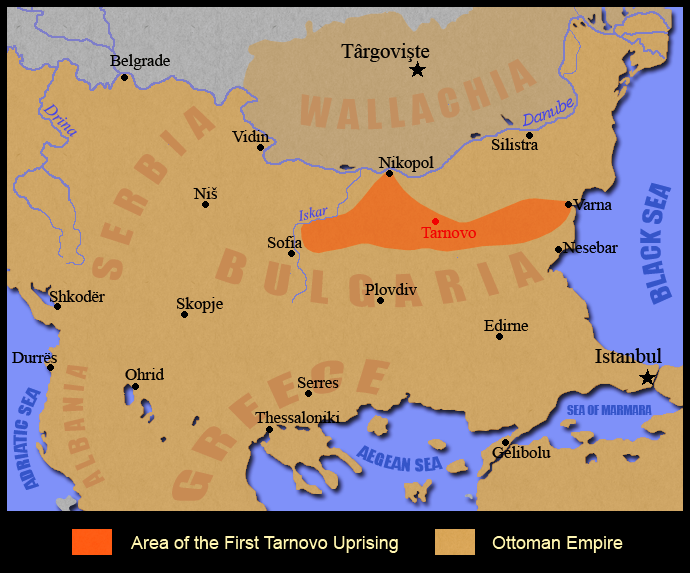
Failed revolts in the 1680s sent new waves of #Bulgarian refugees northward across the #Danube, including many Bulgarian #Catholics who fled the 1688 destruction of #Chiprovtsi and settled in the #Banat region in present-day #Romania and #Serbia.
[Image: commons.wikimedia.org/wiki/File:Bulg…]
[Image: commons.wikimedia.org/wiki/File:Bulg…]
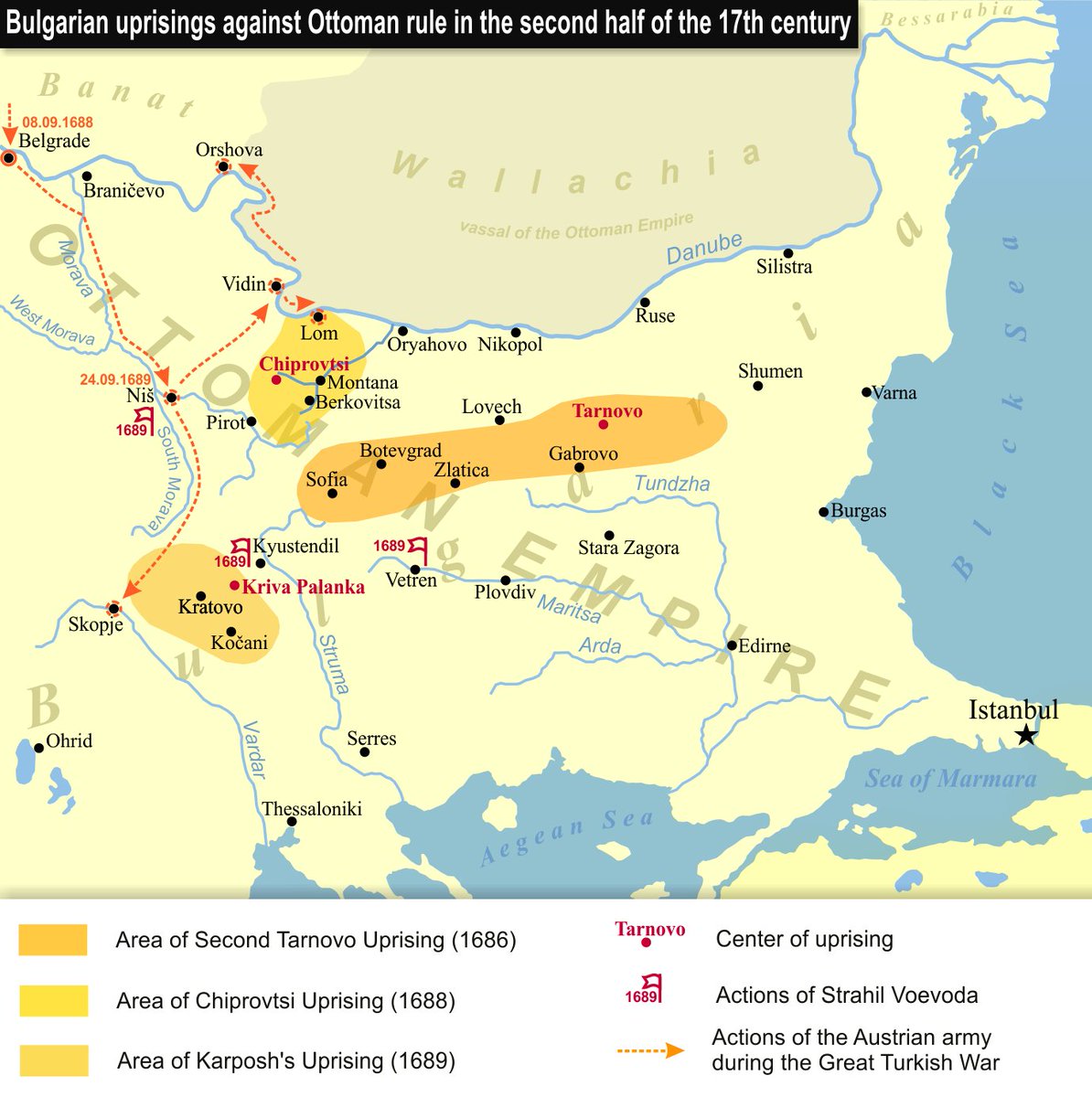
The #Bulgarian-speakers who fled to #Banat in 1688 were mainly descended from the #Paulicians, an originally-#Armenian religious sect that migrated to the #Balkan peninsula, and eventually other parts of #Europe, beginning around the 8th century.
[Image: en.wikipedia.org/wiki/File:Spre…]
[Image: en.wikipedia.org/wiki/File:Spre…]

Research on the southern #Bulgarian #Rup #dialects by #Danish #linguist Holger Pedersen and others shows #Armenian influence on #grammar and #vocabulary.
Areas of #Bulgaria that were populated by #Paulicians also feature personal names (#anthroponyms) of Armenian origin.
Areas of #Bulgaria that were populated by #Paulicians also feature personal names (#anthroponyms) of Armenian origin.

The #Paulicians of #Bulgaria adopted not only the #Bulgarian #language but also the local religions, converting to Eastern Orthodoxy, #Islam, or Roman #Catholicism.
The Bulgarians who fled to #Banat after the 1688 #Chiprovtsi Uprising were mainly #Catholics of #Paulician origin.
The Bulgarians who fled to #Banat after the 1688 #Chiprovtsi Uprising were mainly #Catholics of #Paulician origin.

To this day a few thousand #Bulgarian #Catholics live in the #Banat region of #Romania and #Serbia. They still identify as #Paulician and speak their own #dialect of #Bulgarian infused with loan words from #Romanian, #SerboCroatian, #Hungarian, #German, and #Turkish. 

Influenced by #Bosnian Franciscans, the #Banat #Bulgarian #dialect used the (now extinct) Bosnian #Cyrillic #alphabet. After the 1830s it switched to its own alphabet based on #Gaj's Latin alphabet.
More on these #alphabets later in the thread.
[Image: en.wikipedia.org/wiki/File:Star…]
More on these #alphabets later in the thread.
[Image: en.wikipedia.org/wiki/File:Star…]

The #Cyrillic #DaskalPhilipPsalter was produced in Adjar (Svezhen), #Bulgaria in 1692.
The transition from #MiddleBulgarian to modern #Bulgarian began around the 17th century and continued into the 18th and 19th centuries as the #language underwent #grammar and #syntax changes.
The transition from #MiddleBulgarian to modern #Bulgarian began around the 17th century and continued into the 18th and 19th centuries as the #language underwent #grammar and #syntax changes.

In 1762 #Bulgarian scholar Saint #Paisius of Hilendar wrote #IstoriyaSlavyanobolgarskaya (#Slavonic-Bulgarian History). The book instilled in #Bulgarians a sense of national identity and set the stage for the #BulgarianNationalRevival and renewed resistance to #Ottoman rule. 

The first printed book in modern #Bulgarian, #Nedelnik ('Week' or 'Sunday'), helped to establish Bulgarian as a #literary #language. It was published in 1806 by Saint #Sophronius of #Vratsa, a bishop and acquaintance of #Paisius of #Hilendar. 

The first secular printed book in modern #Bulgarian was the 'Primer with Various Instructions', better known as the #FishPrimer because it featured an illustration of a whale. It was a children's school encyclopaedia written by #PetarBeron in 1824. 

#YuriyVenelin (1802 – 1839) was a #Rusynian #linguist and historian who produced several works about South #Slavic peoples, #languages, and #folklore, including '#Grammar of the modern #Bulgarian #language' and 'On the formation of new Bulgarian #literature'. 

#NeofitRilski (Neophyte of Rila) (1793 – 1881) was a #Bulgarian monk and teacher who promoted the modern Bulgarian #language and sought to unify its Eastern and Western #dialects. In 1835 he published his #BolgarskaGramatika (Bulgarian #Grammar). 

Georgi #Busilin was a #Bulgarian scholar and promoter of pan-#Slavic unity.
In 1844 he published the Bulgarian Primer to offer schools more Bulgarian-#language educational materials. The #alphabet book and reading guide includes material from #YuriyVenelin and others.
In 1844 he published the Bulgarian Primer to offer schools more Bulgarian-#language educational materials. The #alphabet book and reading guide includes material from #YuriyVenelin and others.

In the later decades (1840s – 1870s) of the #BulgarianNationalRevival, #Bulgarian #literature flourished, often with revolutionary, anti-#Turkish themes.
Georgi Sava #Rakovski (1821 – 1867) documented the deeds of the #Haidutin, Bulgarian outlaws who attacked #Ottoman forces.
Georgi Sava #Rakovski (1821 – 1867) documented the deeds of the #Haidutin, Bulgarian outlaws who attacked #Ottoman forces.

Following a long struggle by #Bulgarian clergy to break free of the Patriarch of #Constantinople, the #Ottoman authorities finally restored the Bulgarian Church in 1870. After centuries of an imposed #Greek liturgy, #Bulgarians could freely worship in their own #Slavic #language. 

The first #cookery book in #Bulgarian, '#Cookbook or Tableware for All Kinds of Guests, As They Do in #Tsarigrad', was published in 1870. Tsarigrad is a #Slavic name for #Constantinople.
The author, Petko #Slaveikov (1827 – 1895), was a poet, folklorist, and politician.
The author, Petko #Slaveikov (1827 – 1895), was a poet, folklorist, and politician.

Following a #Bulgarian uprising in 1876 and the horrifically bloody Russo-#Turkish War in 1877–78, the #Balkan states gained de facto independence from the #Ottoman Empire in 1878. #Bulgaria became formally independent in 1908. Many #Turks fled Bulgaria for #Turkey. 

The #RussianEmpire was the primary force behind the liberation of the #Balkan states. #Russia's involvement in the region continued after the war.
The #Tarnovo Constitution, #Bulgaria's first, was written in 1879 in both #Russian and #Bulgarian. It remained in use until 1947.
The #Tarnovo Constitution, #Bulgaria's first, was written in 1879 in both #Russian and #Bulgarian. It remained in use until 1947.

In 1879 #Slovene #linguist Anton #Bezenšek created a #shorthand #writing system for the #Bulgarian #language. He based it on a #Czech variant of the #Gabelsberger shorthand, which was originally developed around 1817 for the #German language.
[Image: en.wikipedia.org/wiki/File:Beze…]
[Image: en.wikipedia.org/wiki/File:Beze…]

Throughout the 19th century #Bulgarian nationalists made numerous attempts to standardise their South #Slavic #language. However, they were divided over which #dialect — or #dialects — should serve as the basis for a national standard. 

Unifiers like Neofit #Rilski held that a standard #Bulgarian #language should be developed by combining eastern and western Bulgarian #dialects, including the #Slavic dialects of #Macedonia, which for centuries were generally considered to be Bulgarian dialects. 
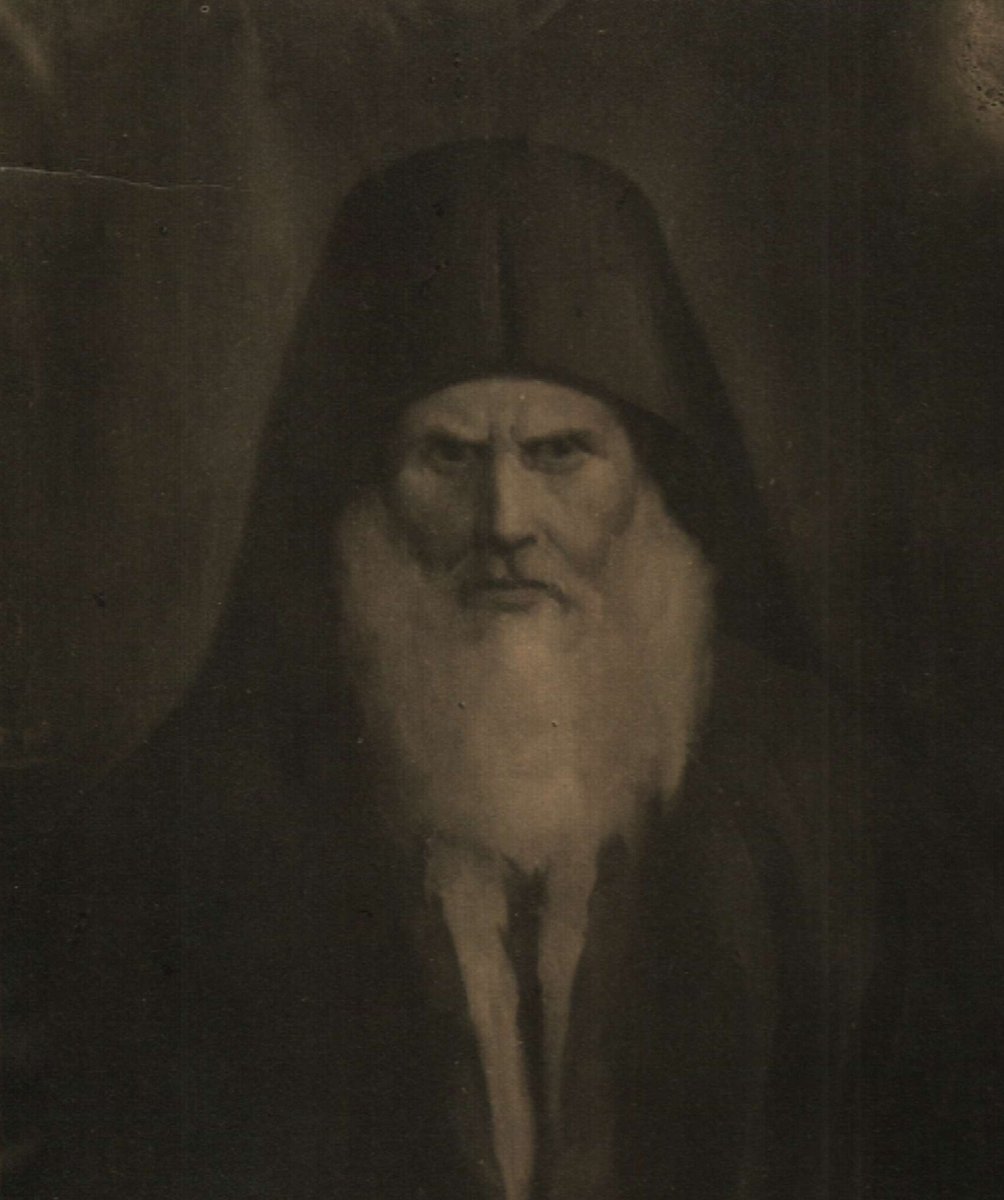
Other #Bulgarian nationalists like Marin #Drinov (1838–1906) considered Rilski's hybrid approach to #language standardisation to be unnatural and infeasible.
Drinov prevailed. An 1899 decree set the first official standard for Bulgarian #orthography based on an eastern #dialect.
Drinov prevailed. An 1899 decree set the first official standard for Bulgarian #orthography based on an eastern #dialect.

#Drinov's standard #Bulgarian #alphabet had 32 #Cyrillic letters, including two #vowels, Ѣ (#yat) and Ѫ (#yus), that were later removed during a 1945 #orthographic reform.
This chart shows how to transliterate today's 30 Bulgarian Cyrillic letters into the #Latin alphabet.
This chart shows how to transliterate today's 30 Bulgarian Cyrillic letters into the #Latin alphabet.

The #pronunciation of the vowel Ѣ (#yat) was the primary marker that distinguished western #Bulgarian #dialects from eastern ones.
West of the 'yat border', #Ѣ was pronounced like the e in 'bed'. In the east it was sometimes pronounced 'ya'.
[Image: en.wikipedia.org/wiki/File:Bgma…]
West of the 'yat border', #Ѣ was pronounced like the e in 'bed'. In the east it was sometimes pronounced 'ya'.
[Image: en.wikipedia.org/wiki/File:Bgma…]

Beyond the main east-west split along the #yat border, other minor #phonological and #morphological differences sift the few dozen #Bulgarian #dialects into a handful of groups.
Standard Bulgarian is based mostly on the Central #Balkan #dialect.
[Image: en.wikipedia.org/wiki/File:Bulg…]
Standard Bulgarian is based mostly on the Central #Balkan #dialect.
[Image: en.wikipedia.org/wiki/File:Bulg…]
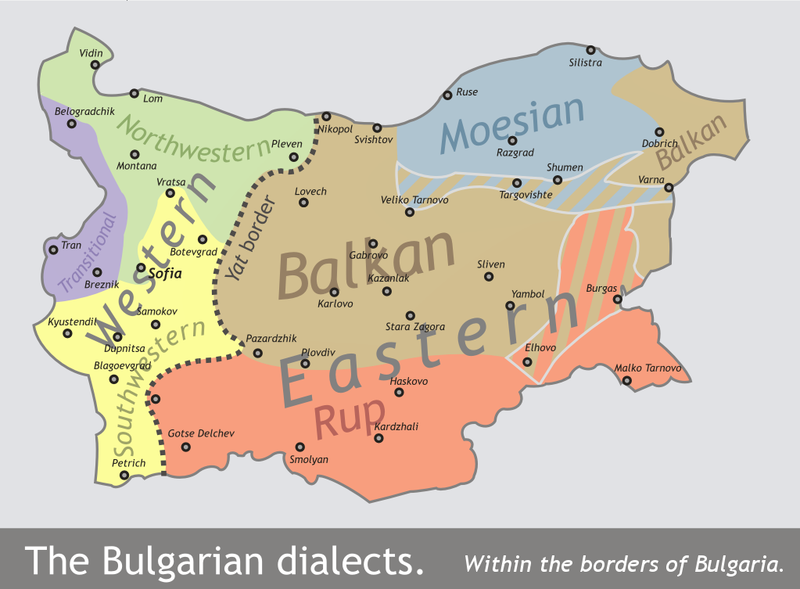
Some #Rup and Southwestern #Bulgarian #dialects are spoken by #Slavic minorities in northern #Greece and northwestern #Turkey.
Historically Bulgarian areas of #Thrace were coloured green in this 1912 #ethnographic map.
Historically Bulgarian areas of #Thrace were coloured green in this 1912 #ethnographic map.
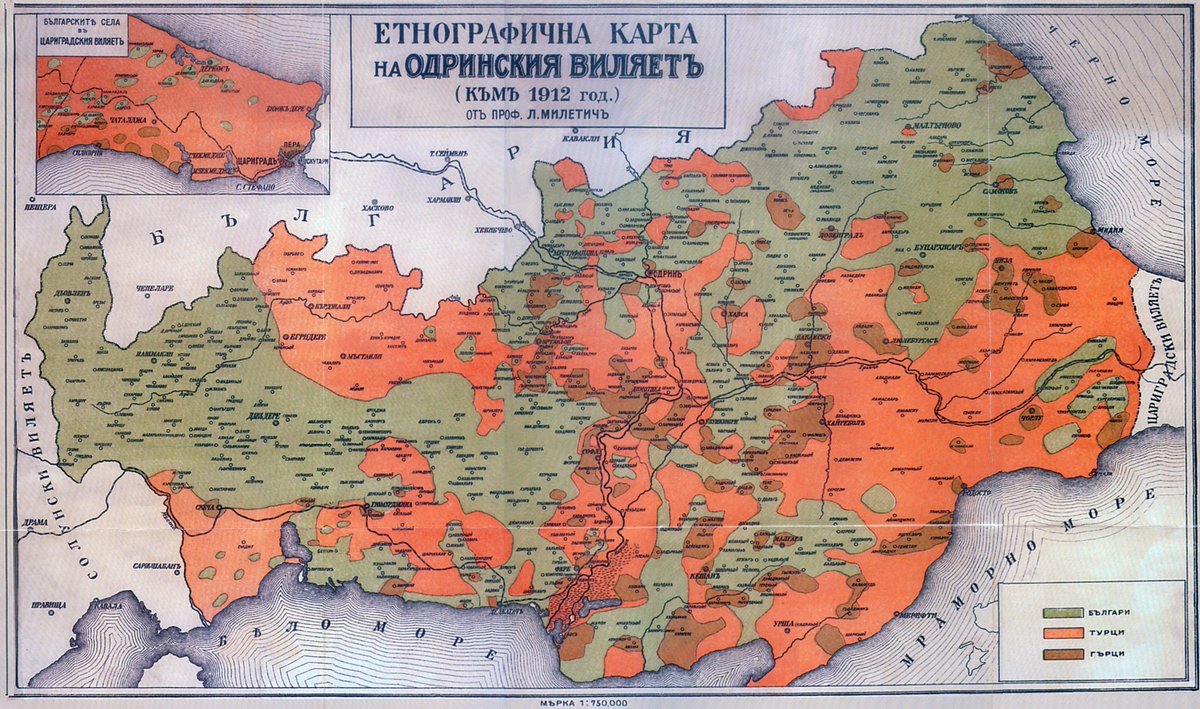
For a few centuries #Anatolia, #Turkey had ~20 #Bulgarian-speaking villages south of the Sea of #Marmara, including one in present-day #Karacabey called #Bulgarköy.
In 1914 the #Anatolian #Bulgarians were deported to #Bulgaria following the #BalkanWars. Refugees from #Çataltepe:
In 1914 the #Anatolian #Bulgarians were deported to #Bulgaria following the #BalkanWars. Refugees from #Çataltepe:

During the wars and unrest of the 18th and 19th centuries, masses of #Bulgarian refugees migrated to the southern parts of #Bessarabia, a historic region in present-day #Moldova and #Ukraine.
To this day hundreds of thousands of #Bessarabian #Bulgarians still speak Bulgarian.
To this day hundreds of thousands of #Bessarabian #Bulgarians still speak Bulgarian.

A 2004 census of #Moldova (excluding the breakaway region of #Transnistria) counted ~65K #Bessarabian #Bulgarians (brown on map), nearly 2% of the country's population. Among them, nearly 55% declared #Bulgarian to be their first #language.
[Image: en.wikipedia.org/wiki/File:Hart…]
[Image: en.wikipedia.org/wiki/File:Hart…]

#Tvardița ('#Твърдица' in #Bulgarian) is a Bulgarian-speaking town of ~5,400 in southern #Moldova. It was founded by #Bessarabian #Bulgarians who fled the town of #Tvarditsa in #Bulgaria during the Russo-#Turkish War of 1828–1829.
[Image: commons.wikimedia.org/wiki/File:Tvar…]
[Image: commons.wikimedia.org/wiki/File:Tvar…]

Around 13,300 #Bessarabian #Bulgarians live in the breakaway region of #Transnistria (2.8% of the population) according to a 2015 census. Most live in #Parcani (pop. ~10,500), the largest majority-#Bulgarian-speaking town outside #Bulgaria.
[Image: commons.wikimedia.org/wiki/File:Park…]
[Image: commons.wikimedia.org/wiki/File:Park…]

More than 200K Bulgarians live in #Ukraine. The southern region of #Budjak alone is home to nearly 130K #Bessarabian #Bulgarians, some of whom are gradually switching from the #Bulgarian #language to #Ukrainian or #Russian.
[Image: ukrainer.net/bulgarians/]
[Image: ukrainer.net/bulgarians/]

#Linguist and #historian Aleksandar Teodorov-#Balan (1859 – 1959) was a #Bessarabian #Bulgarian from #Budjak in present-day #Ukraine. He was a specialist in the #history, #grammar, and #phonology of the Bulgarian #language.
[Image: en.wikipedia.org/wiki/File:Alex…]
[Image: en.wikipedia.org/wiki/File:Alex…]
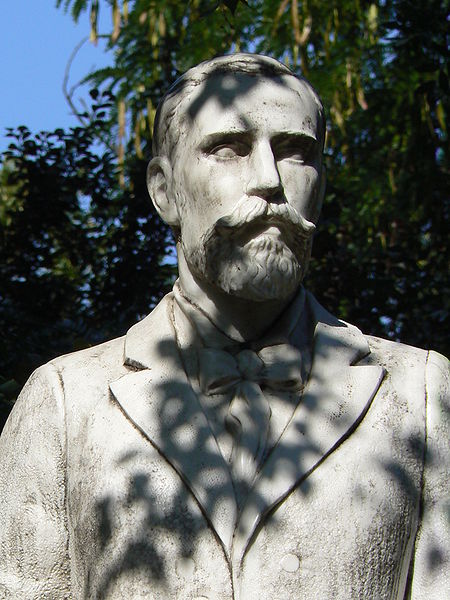
In 1861 many #BessarabianBulgarians moved to the #RussianEmpire's #Taurida Governorate, which consisted of #Crimea and the nearby mainland. An 1897 census counted 41K.
#Stalin forcibly relocated thousands of #Tauridan #Bulgarians to other parts of the #SovietUnion during #WWII.
#Stalin forcibly relocated thousands of #Tauridan #Bulgarians to other parts of the #SovietUnion during #WWII.
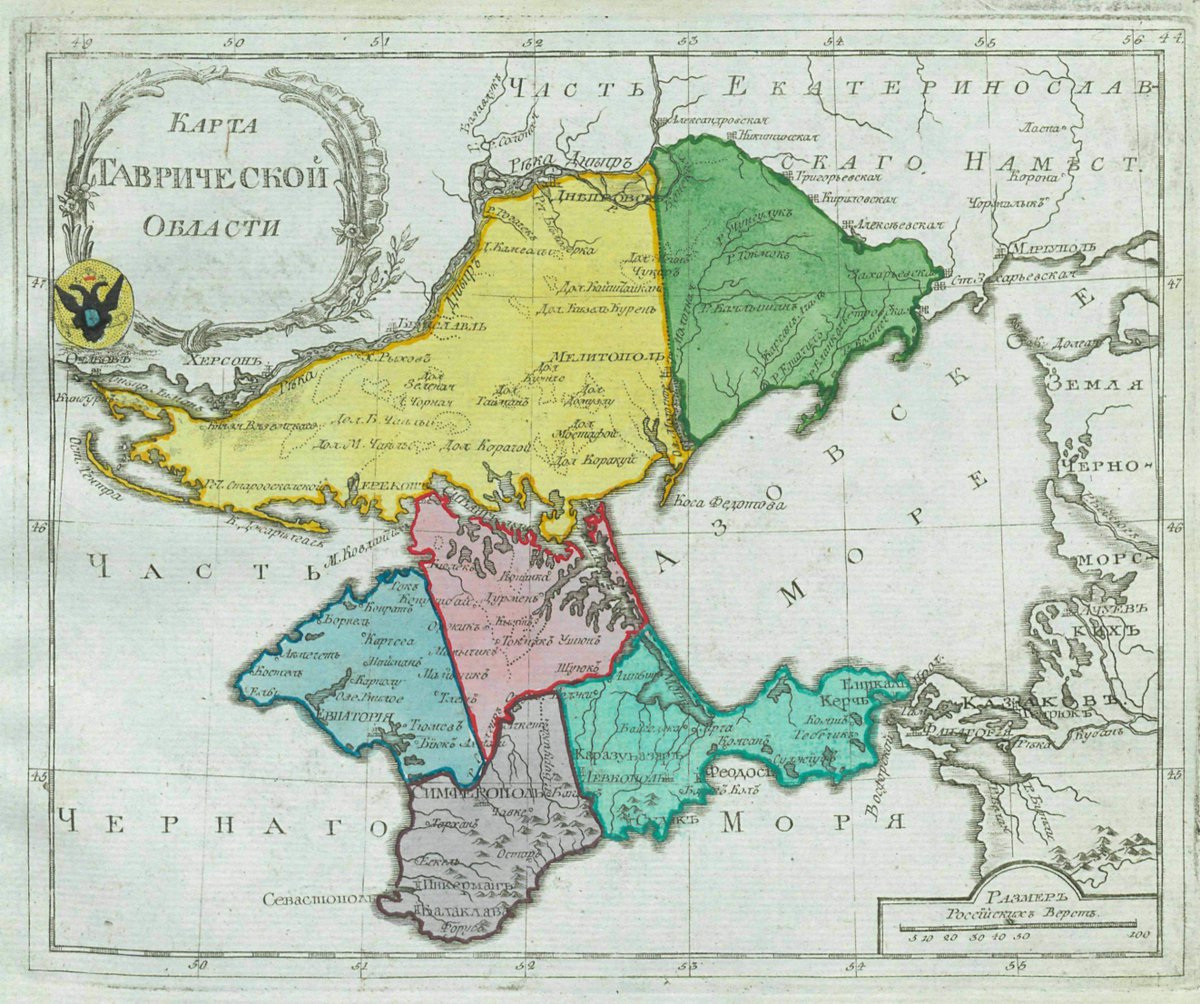
Waves of migration from #Bulgaria in the 19th, 20th, and 21st centuries have led to the formation of #Bulgarian-speaking communities across #Europe, #NorthAmerica, and beyond.
Bulgarian restaurants in #Haringey, #London.
[Image: Google Maps Street View]
Bulgarian restaurants in #Haringey, #London.
[Image: Google Maps Street View]

#Bulgaria operates the St. Kliment Ohridski research base in the #SouthShetlandIslands of #Antarctica.
#Bulgarian #toponyms have been assigned to over a thousand #Antarctic #geographic features. #Karlovo Peak was named after a town in #Bulgaria.
[Image: en.wikipedia.org/wiki/File:Karl…]
#Bulgarian #toponyms have been assigned to over a thousand #Antarctic #geographic features. #Karlovo Peak was named after a town in #Bulgaria.
[Image: en.wikipedia.org/wiki/File:Karl…]

#Bulgarian is a South #Slavic #language spoken by ~9m people, mostly in #Bulgaria, where it's the official language, and a few nearby countries. It's written mostly in the #Cyrillic #alphabet. (#BanatBulgarian in #Romania uses a #Latin script.)
[Image: en.wikipedia.org/wiki/File:Dist…]
[Image: en.wikipedia.org/wiki/File:Dist…]

The names '#Bulgaria' and '#Bulgarian' come from the #Bulgars, semi-nomadic #Turkic warriors who conquered the lower #Danube in the 7th century. They merged with the local #Slavs and were eventually Slavicised, adopting the Common #Slavic #language of the time. 

More #linguistic research is needed into the structure of #SignLanguage in #Bulgaria. #Linguists have noted that the #BulgarianSignLanguage used by adults appears to differ from the #Russian Sign #Language taught in #Bulgarian schools for the #deaf.
The #BulgarianBraille #alphabet is based on unified international #braille standards. It's nearly identical to #RussianBraille, apart from a few letters that differ between the #Bulgarian and #Russian #Cyrillic #alphabets, like Bulgarian Ѝ. Bulgarian Braille uses the #French '?'. 

During most of its history, the South #Slavic #language spoken in #Macedonia was universally regarded as #Bulgarian.
#Macedonians formed a national identity separate from Bulgarian beginning in the 19th century, and eventually came to see #Macedonian as a distinct language.
#Macedonians formed a national identity separate from Bulgarian beginning in the 19th century, and eventually came to see #Macedonian as a distinct language.

Today's #Slavic #Macedonian #language shouldn't be confused with the language of the ancient #Macedonians before #Slavs arrived in the 6th century. Philip of #Macedon and #AlexanderTheGreat spoke a #Hellenic language, perhaps a northern #dialect of #Greek.
https://twitter.com/linglore/status/1108029087346577408
Some manuscripts written in the #Glagolitic #alphabet in the 10th and 11th centuries include #phonetic features that are specific to the #Macedonia region. These are perhaps the earliest traces of a #Macedonian #dialect of the #OldChurchSlavonic #language.
https://twitter.com/linglore/status/1224005275755122688
A 16th-century #Bulgarian-#Greek #dictionary written in the Greek #alphabet holds the oldest samples of #vocabulary specific to a #Macedonian #dialect. It uses the #Kostur dialect from #Kastoria, a city which today sits in the Western #Macedonia region of northern #Greece. 

Daniel #Moscopolites used a #Macedonian #dialect to represent #Bulgarian in his 1794 #dictionary of four #Balkan #languages.
Despite being #Aromanian himself, he wrote it to entice #Albanians, #Aromanians, and #Bulgarians to switch from their 'barbarian' languages to #Greek.
Despite being #Aromanian himself, he wrote it to entice #Albanians, #Aromanians, and #Bulgarians to switch from their 'barbarian' languages to #Greek.

Some leading figures of the #Bulgarian National Revival were from #Macedonia and wrote in #Macedonian #dialects.
Yoakim #Karchovski (c.1750–1820) wrote to educate common people in their everyday #language. #NorthMacedonia considers him a founder of Macedonian #literature.
Yoakim #Karchovski (c.1750–1820) wrote to educate common people in their everyday #language. #NorthMacedonia considers him a founder of Macedonian #literature.

The #Miladinov brothers, Dimitar (1810–1862) and Konstantin (1830–1862), were poets and #Slavic activists in the #Bulgarian nationalist movement. They were born in #Struga on Lake #Ohrid in the western part of present-day #NorthMacedonia, and spoke the Struga #dialect natively. 

With the help of #Russian #Slavicist Victor #Grigorovich and fellow Bulgarian nationalists including Marin #Drinov, the #Miladinov brothers recorded #Bulgarian folk songs from the #Ottoman Empire.
1846 letter from Dimitar to Grigorovich about the search for songs in #Macedonia.
1846 letter from Dimitar to Grigorovich about the search for songs in #Macedonia.

The #Miladinov brothers originally wrote their collection '#Bulgarian Folk Songs' using the #Greek #alphabet. However, #Croatian Bishop Josip #Strossmayer, a supporter of the Bulgarian national movement, insisted that they rewrite it in #Cyrillic before its publication in 1861. 

The #Miladinov brothers objected to the 19th-century revival of the ancient name '#Macedonia', concerned that it implied a #Greek identity for their mostly #Slavic region.
In this 1861 letter to Georgi #Rakovski, Konstantin Miladinov lobbies for the name 'Western #Bulgaria'.
In this 1861 letter to Georgi #Rakovski, Konstantin Miladinov lobbies for the name 'Western #Bulgaria'.

Born in #Ohrid in present-day #NorthMacedonia, Kuzman #Shapkarev (1834–1909) was a fellow #Bulgarian nationalist who assisted the #Miladinov brothers and later wrote biographical material about them, as well as many other works about #language, folklore, religion, and politics. 

To redress the dominance of eastern #Bulgarian #dialects, which he described as incomprehensible to the #Slavs of #Macedonia, Kuzman #Shapkarev published his 1868 'Bulgarian Reading Book' in his native tongue, 'a #dialect more intelligible to the #Macedonian #Bulgarians'. 

When Kuzman #Shapkarev announced a project to create a #dictionary that would contain #translation from #Macedonian to eastern #Bulgarian, he was denounced in the Bulgarian press and accused of advocating the existence of a separate Macedonian #language, distinct from Bulgarian. 

Kuzman #Shapkarev strove to raise the profile of #Macedonian #dialects. However, he considered his #language and nationality to be #Bulgarian and — despite accusations — did not describe #Macedonia as a 'nation'.
The same can't be said for author Georgi #Pulevski (1817–1895).
The same can't be said for author Georgi #Pulevski (1817–1895).
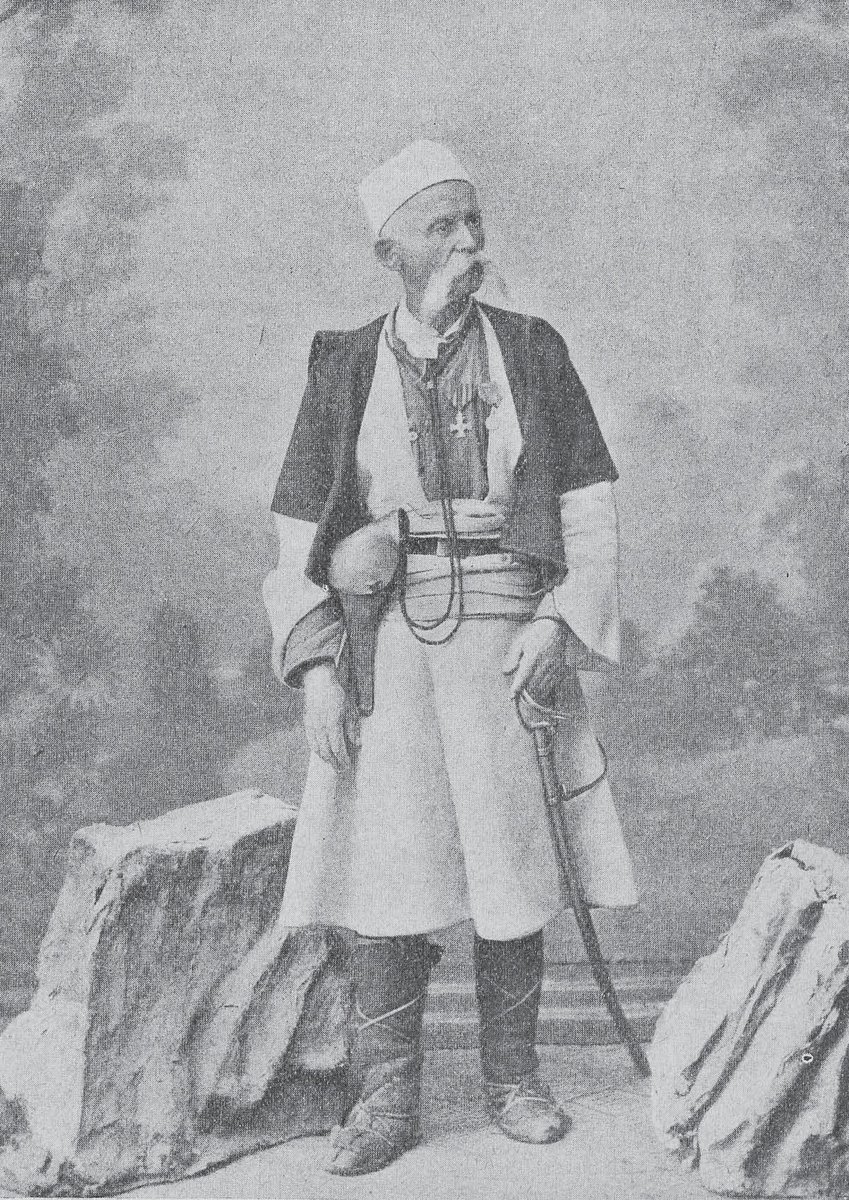
Georgi #Pulevski was born in the #Mijak village of #Galičnik in the #Mijačija region of western #Macedonia. The #Mijaks are a sub-group of #Macedonian #Slavs known for preserving traditional occupations and customs. The Galičnik #dialect features relatively archaic #vocabulary. 

At various times #Pulevski described himself as #Macedonian or #Bulgarian, but also as a '#Serbian patriot', reflecting the ambiguous national identity some #Macedonians felt under #Ottoman rule. He also believed that the ancient Macedonians were #Slavic.
https://twitter.com/linglore/status/1263750586861785095
The ambiguity extended to #linguistic identity, as well. In his 1873 '#Dictionary of Four #Languages', #Pulevski mixed #Macedonian and #Serbian #vocabulary in a column titled 'Serbo-Albanian'. The other columns were labelled 'Arbanian-Arnautian' (#Albanian), #Turkish, and #Greek. 

Two years later #Pulevski published another #lexicon, '#Dictionary of Three #Languages', featuring #Macedonian, #Albanian, and #Turkish, all written in #Cyrillic.
He included spellings from several Macedonian #dialects, but disproportionately favoured his own #Galičnik #dialect.
He included spellings from several Macedonian #dialects, but disproportionately favoured his own #Galičnik #dialect.

It's the book in which #Pulevski became the first author to assert #Macedonian nationhood:
'What do we call a nation? – People who are of the same origin and who speak the same words … Thus the #Macedonians also are a nation and the place which is theirs is called #Macedonia.'
'What do we call a nation? – People who are of the same origin and who speak the same words … Thus the #Macedonians also are a nation and the place which is theirs is called #Macedonia.'

In 1880 #Pulevski published 'Grammar of the Language of the Slavic Macedonian population', the first specifically-Macedonian #grammar and #spelling book. In it he systematically contrasted what he called 'our #language' or '#Slavic-#Macedonian' with both #Serbian and #Bulgarian. 

Though he famously contrasted #Macedonian with #Bulgarian, #Pulevski still saw them as parts of the same whole. In his final grammar book he considers Macedonian #dialects to be Old Bulgarian, and the differences between them purely geographical.
[Image: mk.wikipedia.org/wiki/%D0%9F%D0…]
[Image: mk.wikipedia.org/wiki/%D0%9F%D0…]

The Young #Macedonian #Literary Society, founded in 1891, published its magazine #Loza to promote the inclusion of Macedonian #dialects in the formation of a standard #Bulgarian #language. Its members were Bulgarian nationalists with a Macedonian cultural identity. 

After #Bulgaria selected the eastern #Tarnovo #dialect as the basis for a standardised #Bulgarian #orthography, #Macedonians increasingly gravitated toward the idea that #Macedonian was its own distinct #Slavic #language.
https://twitter.com/linglore/status/1256857760500776964
#Serbia competed with #Bulgaria for influence and control over the #Macedonian region. In the 1890s it operated ~100 #Serbian schools in #Macedonia to promote Serbian nationalism and cultural identity, but with little success. Macedonian #Slavs mostly shunned the Serbian schools. 

#Slavic scholar Krste #Misirkov (1874–1926) was born in this house in the #Ottoman Empire.
The #Slavs called his village #Postol. It's on the site of #Pella, ancient #Macedonia's capital. Today it sits in the #CentralMacedonia region of #Greece and is once again named Pella.
The #Slavs called his village #Postol. It's on the site of #Pella, ancient #Macedonia's capital. Today it sits in the #CentralMacedonia region of #Greece and is once again named Pella.

In 1903 Krste #Misirkov published 'On Macedonian Matters', in which he expressed the need for #Macedonians to be affirmed as a separate people. It's the first book to attempt to codify a distinct #Macedonian #literary #language, including its #alphabet and #orthography. 

When Krste #Misirkov wrote #Vardar, a 1905 scientific #literary magazine about the #Macedonian #language, he used his same #orthographic standard, which he based on the #dialects spoken between the cities of #Prilep and #Bitola in present-day #NorthMacedonia. 
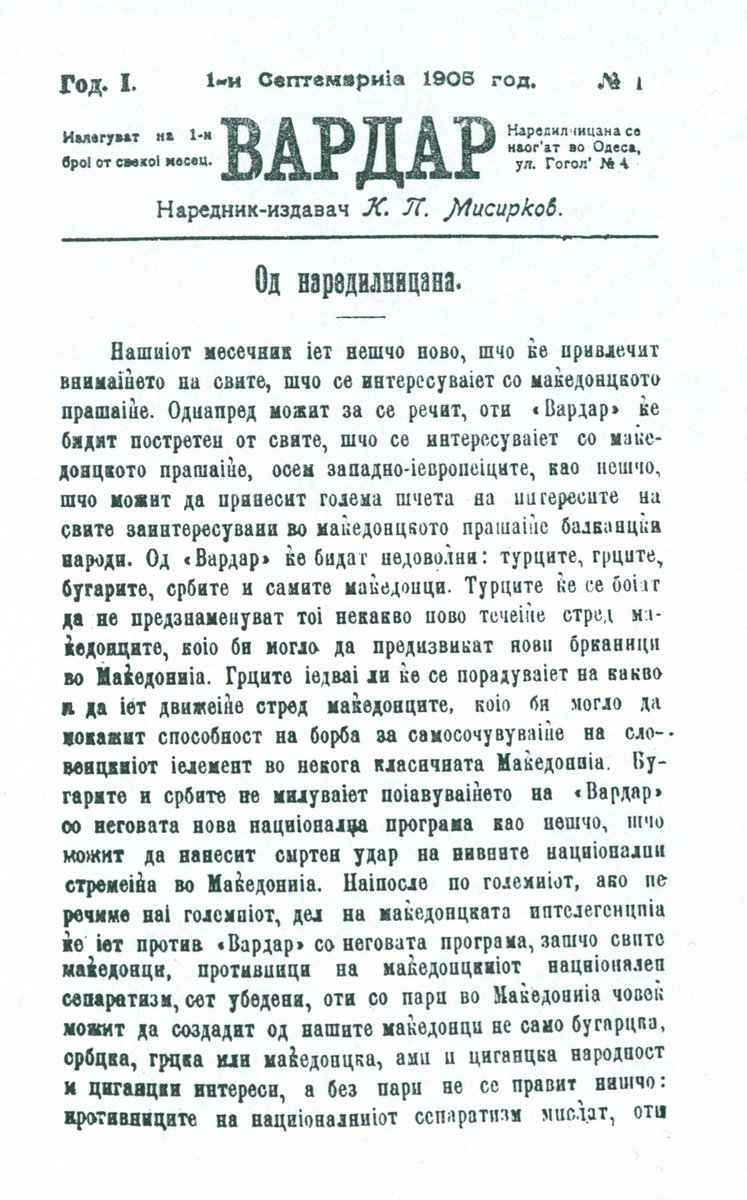
The #BalkanWars in 1912–1913 dramatically changed international borders in the #Balkan peninsula. The #Ottoman Empire lost most of its remaining #European territory; #Albania became independent; and the region of #Macedonia was partitioned between #Greece, #Serbia, and #Bulgaria. 

#Macedonian #Slavs who found themselves on the #Greek side of the new border were expelled or subjected to forced assimilation. Their #language was prohibited and its use punished. Schools and churches were closed. #Greeks from other provinces were settled in southern #Macedonia. 
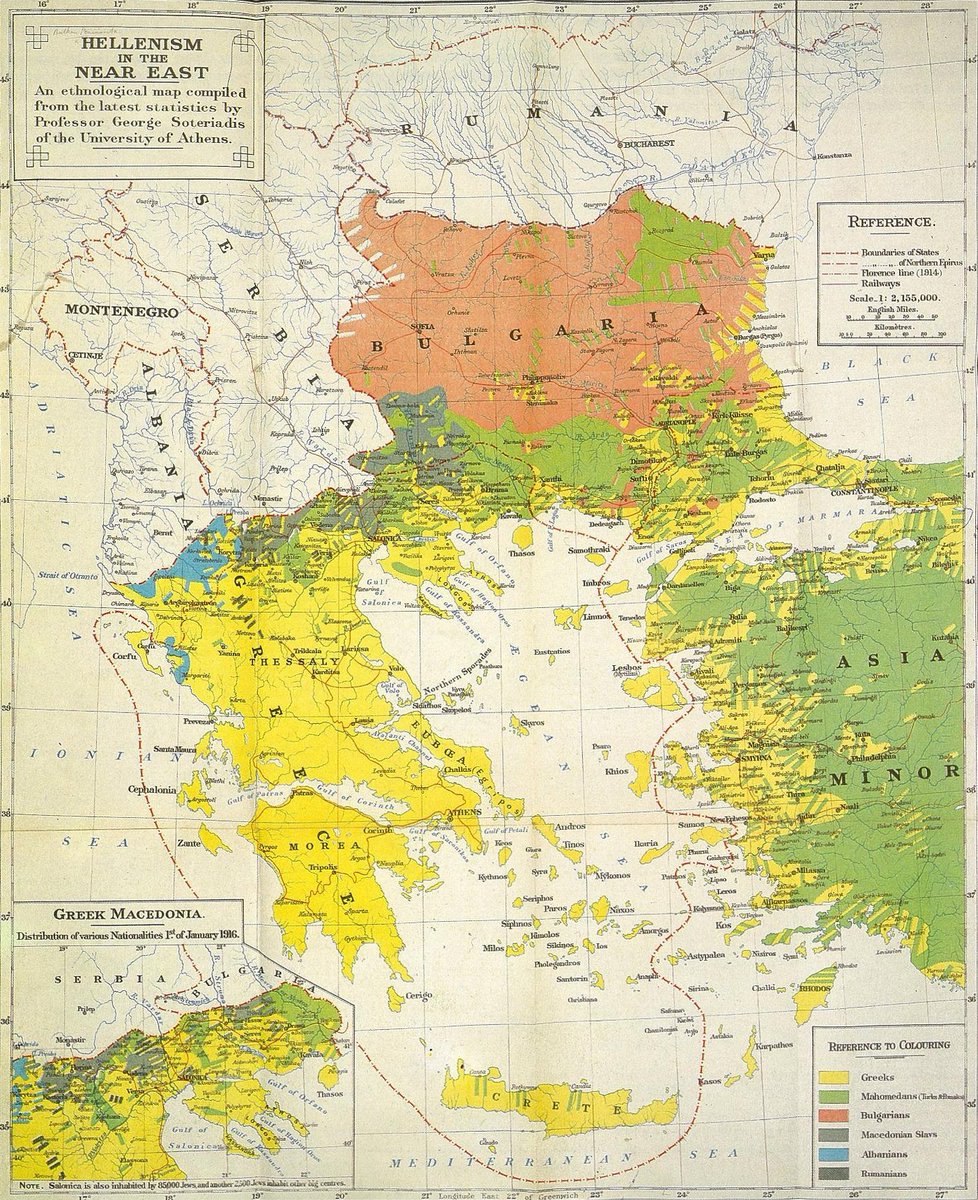
#Serbia also enforced a brutal policy of forced assimilation in the part of #Macedonia that it annexed. #Macedonians who refused to declare as #Serbs were beaten and tortured. Non-#Serbian names were #Serbianised.
#Macedonian refugees forcibly expelled to #Bulgaria around 1913:
#Macedonian refugees forcibly expelled to #Bulgaria around 1913:

Suppression of the #Macedonian identity continued after the 1918 formation of #Yugoslavia. Macedonian #dialects were referred to as dialects of #SerboCroatian. The area that includes present-day #NorthMacedonia was subsumed into the province of South #Serbia (light green on map). 

In 1934 the #Communist International (#Comintern) in #Moscow adopted a resolution recognising the existence of a distinct #Macedonian nation and #language, the first authoritative international organisation to do so. Its aim was to undermine the countries that ruled #Macedonia. 

#Bulgaria joined the Axis Powers in 1941 and occupied most of #Macedonia. Many #Macedonians who still felt a #Bulgarian national identity welcomed the invasion.
Bulgaria built Bulgarian-#language schools and a university to reverse decades of #Hellenisation and #Serbianisation.
Bulgaria built Bulgarian-#language schools and a university to reverse decades of #Hellenisation and #Serbianisation.

#Bulgaria's efforts to cultivate pro-#Bulgarian sentiment and re-establish the Bulgarian #language were undermined by its oppressive occupation of #Macedonia.
#Communist #Macedonian #Partisans formed an armed resistance to Bulgaria and its #Axis partners, #Germany and #Italy.
#Communist #Macedonian #Partisans formed an armed resistance to Bulgaria and its #Axis partners, #Germany and #Italy.

The #Axis defeat in 1945 led to the re-partitioning of #Macedonia between #Greece, #Yugoslavia, and #Bulgaria.
The #Bulgarian part is often called #PirinMacedonia, a name some #Bulgarians oppose, believing it promotes separatism.
The #Pirin Mountains of southwestern Bulgaria:
The #Bulgarian part is often called #PirinMacedonia, a name some #Bulgarians oppose, believing it promotes separatism.
The #Pirin Mountains of southwestern Bulgaria:

Whereas pre-War #Yugoslavia suppressed all things #Macedonian, the new #Communist rulers embraced the Macedonian identity with the aim of blunting any pro-#Bulgarian sentiment. They adopted #Misirkov's 1903 standard for Macedonian and made it an official #language of Yugoslavia. 

Yugoslavia's #Communist government also restored the name '#Macedonia'. In 1946 it established the People's Republic of Macedonia (renamed the #Socialist Republic of Macedonia in 1963) as one of the six constituent countries of #Yugoslavia.
[Image: en.wikipedia.org/wiki/File:Loca…]
[Image: en.wikipedia.org/wiki/File:Loca…]

#Communist #Yugoslavia systematically erased #Macedonians' age-old #Bulgarian identity by indoctrinating generations of pupils with a faked past. In 1962 they published the #Miladinov brothers' work, but replaced 'Bulgarian' with '#Macedonian' throughout.
https://twitter.com/linglore/status/1267725566486155265
In the late 1960s #Yugoslavia's campaign of distortion to purge #Macedonia of its #Bulgarian identity reached further back to the #MiddleAges. The 1969 '#History of the Macedonian Nation' deceivingly rebranded Tsar Samuel of #Bulgaria as '#Macedonian'.
https://twitter.com/linglore/status/1231248999652478977
After #Macedonia gained independence in 1991, its government perpetuated their #Yugoslav predecessors' policy of historical fabrication. It erected statues implying a direct link between modern (#Slavic) Macedonia and #AlexanderTheGreat's ancient (#Hellenic) kingdom of #Macedon. 

Concerned that the newly independent country's name implied a claim to the part of #Macedonia within #Greece's borders, the #Greek government disputed the name from 1991 until 2019, when the two countries officially agreed on the new name 'Republic of #NorthMacedonia'. 

Thousands of #Slavs along the eastern edge of #Albania speak #Macedonian #dialects. Many identify as Macedonian; others as #Bulgarian or #Albanian.
#Macedonians are a recognised ethnic minority. In the #MalaPrespa area, they form a majority.
[Image: en.wikipedia.org/wiki/File:Alba…]
#Macedonians are a recognised ethnic minority. In the #MalaPrespa area, they form a majority.
[Image: en.wikipedia.org/wiki/File:Alba…]

#Macedonian is one of five official #languages in the municipality of #Plandište in northeastern #Serbia. (The others are #Serbian, #Hungarian, #Slovak, and #Romanian.)
Around 1K of Serbia's 22K #Macedonians live in Plandište, forming 9% of the municipality's population.
Around 1K of Serbia's 22K #Macedonians live in Plandište, forming 9% of the municipality's population.

Since the late 19th century hundreds of thousands of #Macedonians have emigrated to points around the globe, gradually adopting the #languages of their host countries. Some were seasonal workers who then settled.
A #Macedonian saloon in 1913 in #GraniteCity, #Illinois, #USA:
A #Macedonian saloon in 1913 in #GraniteCity, #Illinois, #USA:

#Macedonian emigration surged after #WWII and the #GreekCivilWar (1943–1949). Many moved to #Australia, where a 2016 census counted more than 66K people who speak Macedonian at home.
Map of Macedonian ancestry as a percentage of the population:
[Image: en.wikipedia.org/wiki/File:Aust…]
Map of Macedonian ancestry as a percentage of the population:
[Image: en.wikipedia.org/wiki/File:Aust…]

#Macedonian belongs to the eastern sub-group of the South #Slavic #languages and is mutually intelligible with #Bulgarian. Most of its roughly 2M speakers live in or near North #Macedonia, where it's an official #language.
Lake #Ohrid, #NorthMacedonia:
Lake #Ohrid, #NorthMacedonia:

Some sounds like /x/ (the ⟨ch⟩ in loch) have been preserved in Eastern #Macedonian #dialects, but lost in Central and Western dialects:
връх→врв (peak)
Standard Macedonian is based mainly on the Central dialects spoken in #Prilep and #Bitola.
[Image: en.wikipedia.org/wiki/File:Mace…]
връх→врв (peak)
Standard Macedonian is based mainly on the Central dialects spoken in #Prilep and #Bitola.
[Image: en.wikipedia.org/wiki/File:Mace…]

The #Macedonian #alphabet has 31 letters, 28 of which are in common with the #Serbian alphabet on which it's largely based.
Ѓ (#Gje), Ќ (#Kje), and Ѕ (#Dze) are unique to Macedonian. #Cyrillic Ѕ looks like the #Latin letter S, but is not directly related to it.
Ѓ (#Gje), Ќ (#Kje), and Ѕ (#Dze) are unique to Macedonian. #Cyrillic Ѕ looks like the #Latin letter S, but is not directly related to it.
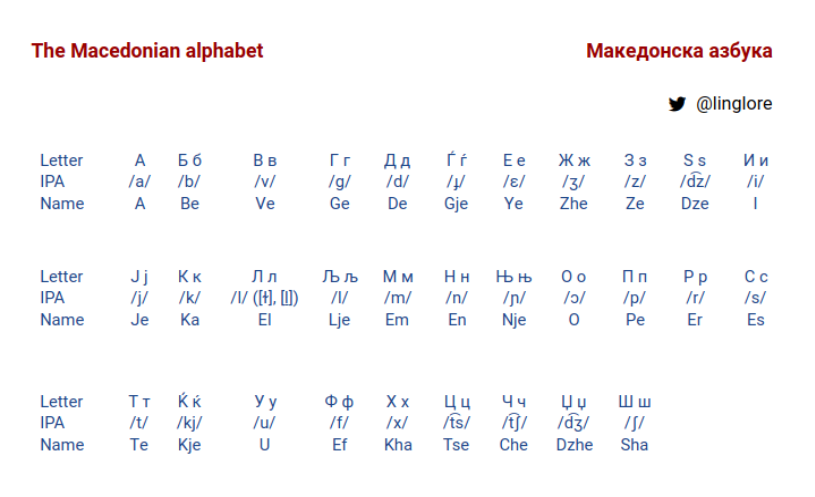
When #Yugoslav authorities standardised Macedonian in the 1940s they drew on Misirkov's #orthography, but made a few Serbian substitutions:
#IPA:
/j/ /l/ /ɲ/ /dʒ/
#Misirkov:
І Л' Н' ДЖ
#Serbian and standard #Macedonian:
Ј Љ Њ Џ
#IPA:
/j/ /l/ /ɲ/ /dʒ/
#Misirkov:
І Л' Н' ДЖ
#Serbian and standard #Macedonian:
Ј Љ Њ Џ
https://twitter.com/linglore/status/1280822490168799244
#Macedonian #SignLanguage is used by the deaf community in #NorthMacedonia. A 2009 national law defines the #language and spells out the rights of #deaf people.
The 31 signs of #MacedonianSignLanguage's #alphabet, below. Another type of the alphabet is expressed with two hands.
The 31 signs of #MacedonianSignLanguage's #alphabet, below. Another type of the alphabet is expressed with two hands.

South #Slavic has two sub-groups:
Eastern: #Bulgarian, #Macedonian
Western: #SerboCroatian, #Slovene
Where they meet, a set of transitional '#Torlakian' #dialects bear characteristics of both, and are variously classified in either sub-group.
[Image: en.wikipedia.org/wiki/File:Torl…]
Eastern: #Bulgarian, #Macedonian
Western: #SerboCroatian, #Slovene
Where they meet, a set of transitional '#Torlakian' #dialects bear characteristics of both, and are variously classified in either sub-group.
[Image: en.wikipedia.org/wiki/File:Torl…]

The first known #literary document to include text in a #Torlakian #dialect (along with #ChurchSlavonic text) is a 1764 #manuscript from the #Temska Monastery in southeastern #Serbia. Its author, Monk Kiril #Zhivkovich (1730–1807), described his #language as 'simple #Bulgarian'. 

One of the early influential figures of the #Bulgarian National Revival, Kiril #Peychinovich (1770–1865), wrote religious works in his native #Tetovo #dialect, a #Torlakian dialect spoken in present-day #NorthMacedonia.
Foreword to his 'Solace of the Sinner', written in 1831:
Foreword to his 'Solace of the Sinner', written in 1831:
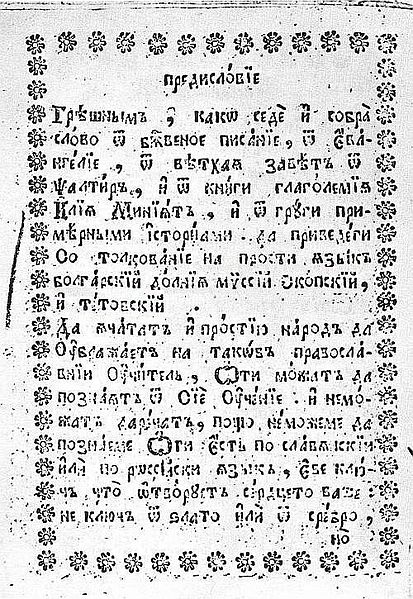
A few thousand Roman #Catholic #Krashovani (#Krašovani or #Carasovan) people live in the #Carașova area in western #Romania. They speak a #Torlakian #Slavic #dialect and identify as #Croatian. Their ancestors migrated from northwestern #Bosnia in the 13th and 14th centuries. 

The #Gora ('highland') region in #Kosovo, #Albania, and #NorthMacedonia is home to the #Gorani people, a mostly-#Muslim #Slavic ethnic group. Around 60K speak Gorani (#Goranski or #Našinski), which some #linguists consider a #Torlakian #dialect.
[Image: en.wikipedia.org/wiki/File:%D0%…]
[Image: en.wikipedia.org/wiki/File:%D0%…]

In #Kosovo and #NorthMacedonia, #Gorani is written in either the #Serbian or #Macedonian #Cyrillic #alphabets.
In #Albania the #Latin #Albanian #alphabet is used.
A Gorani woman from the village of #Shishtavec in #Kukës County, Albania:
[Image: en.wikipedia.org/wiki/File:Vesh…]
In #Albania the #Latin #Albanian #alphabet is used.
A Gorani woman from the village of #Shishtavec in #Kukës County, Albania:
[Image: en.wikipedia.org/wiki/File:Vesh…]

Because #Torlakian #dialects are transitional, with traits of both the Eastern and Western sub-groups of the South #Slavic #languages, #Bulgarian, #Macedonian, and #SerboCroatian speakers each claim them as part of their own #language.
#Torlak crafts from #Chiprovtsi, #Bulgaria:
#Torlak crafts from #Chiprovtsi, #Bulgaria:

#SerboCroatian is the primary #language of #Croatia, #Serbia, #BosniaAndHerzegovina, and #Montenegro. It has 18-21M speakers.
This map shows in cyan areas where it was the most widely-spoken language as of 2005 (which was before Montenegro and #Kosovo became independent).
This map shows in cyan areas where it was the most widely-spoken language as of 2005 (which was before Montenegro and #Kosovo became independent).

#Croats, #Bosniaks (#Bosnian #Muslims), and #Montenegrins mostly use the #Latin script to write #SerboCroatian.
Although #Serbs have historically used #Cyrillic, the Latin script is increasingly favoured in #Serbia, in part because it's easier to use on phones and computers.
Although #Serbs have historically used #Cyrillic, the Latin script is increasingly favoured in #Serbia, in part because it's easier to use on phones and computers.

During the #MiddleAges, the #language spoken in the western #Balkans began to diverge from earlier varieties of #Slavic such as the #Croatian and #Serbian recensions of #ChurchSlavonic, which were mostly written in the #Glagolitic and #Cyrillic scripts.
https://twitter.com/linglore/status/1239827697364238336
#MiroslavsGospel is one of the earliest #Cyrillic manuscripts that shows part of the gradual transition from #OldChurchSlavonic to #SerboCroatian. It was commissioned in 1186 by #Miroslav #Zavidović, a #Serbian royal, and transcribed in #Kotor in modern-day #Montenegro. 

The Fragmenta #Vindobonensia, also known as the #ViennaFolios, are a pair of illuminated folios written using the #Glagolitic script. They most likely originated in the 11th or 12th century in #Dalmatia or in Central #Croatia. They're now kept in the National Library in #Vienna. 

#BosnianCyrillic (#Bosančica or #Bosanica) is an extinct form of #Cyrillic that originated in #Bosnia around the 10th or 11th century and was used in Bosnia and #Dalmatia (southern #Croatia) until the 20th century.
[Image: en.wikipedia.org/wiki/File:Bos-…]
[Image: en.wikipedia.org/wiki/File:Bos-…]

Some #Serbs reject the name '#BosnianCyrillic' because they consider the #alphabet to be a variant of #Serbian #Cyrillic.
Similarly, some #Croats regard it as #Croatian, and refer to it as 'Western Cyrillic' or '#Arvatica' (Croatian script).
[Image: en.wikipedia.org/wiki/File:Alte…]
Similarly, some #Croats regard it as #Croatian, and refer to it as 'Western Cyrillic' or '#Arvatica' (Croatian script).
[Image: en.wikipedia.org/wiki/File:Alte…]

This tablet, documenting the construction of a church, was found in the village of #Humac in #BosniaAndHerzegovina. Believed to date from the 10th or 11th century, it's the oldest known artefact inscribed using #Bosnian #Cyrillic. It also includes five #Glagolitic letters. 

The Charter of #BanKulin, a trade agreement between the Banate of #Bosnia and the Republic of #Ragusa (#Dubrovnik), was written in 1189 in both #Latin and an old form of #Shtokavian, the #dialect on which modern #SerboCroatian is based. The #Slavic part uses #Bosnian #Cyrillic. 

Most artefacts that feature #Bosnian #Cyrillic were found in either #Bosnia or #Dalmatia. The 12th-century #Supetar fragment is an exception. It was discovered in the #Istrian village of Sveti Petar u Šumi in northwestern #Croatia. The second line is written in #Glagolitic. 

Tens of thousands of ornate tombstones known as #stećci (singular #stećak) were erected in #BosniaAndHerzegovina and nearby parts of surrounding countries from the 12th to the 16th centuries. Many are inscribed in #Bosnian #Cyrillic; others in #Glagolitic or the #Latin script. 
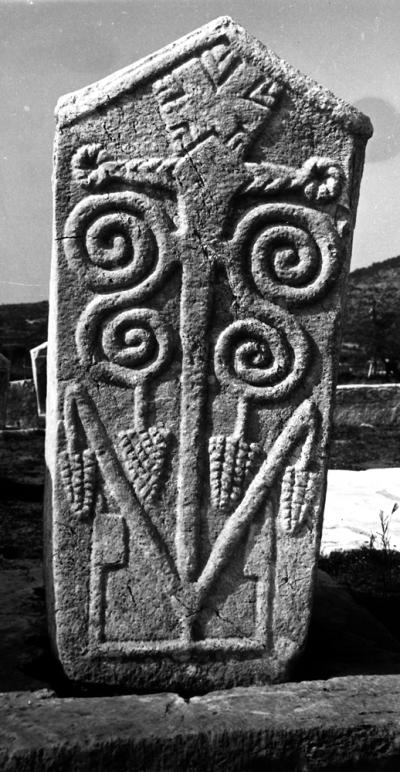
#HvalsCodex was created in 1404 in the city of #Split in present-day #Croatia. It's a religious manuscript of the #BosnianChurch, written in #Ikavian, a variety of the #Shtokavian #dialect.
It uses the #Bosnian #Cyrillic #alphabet with an introduction written in #Glagolitic.
It uses the #Bosnian #Cyrillic #alphabet with an introduction written in #Glagolitic.

The #SerboCroatian-speaking region has three main #dialect areas:
#Kajkavian: northern #Croatia
#Chakavian: mainly western Croatia
#Shtokavian: most of the rest of the region
This map shows the dialect areas before 16th century migrations, overlaid with 2013 national borders.
#Kajkavian: northern #Croatia
#Chakavian: mainly western Croatia
#Shtokavian: most of the rest of the region
This map shows the dialect areas before 16th century migrations, overlaid with 2013 national borders.

The name of each #SerboCroatian #dialect group comes from its word for 'what':
#Kajkavian: kaj
#Chakavian: ča (cha)
#Shtokavian: što (shto) [šta in eastern #dialects]
This 1912 #Croatian prayer book is written in a blend of Kajkavian and Shtokavian. It uses 'kaj' for 'what'.
#Kajkavian: kaj
#Chakavian: ča (cha)
#Shtokavian: što (shto) [šta in eastern #dialects]
This 1912 #Croatian prayer book is written in a blend of Kajkavian and Shtokavian. It uses 'kaj' for 'what'.
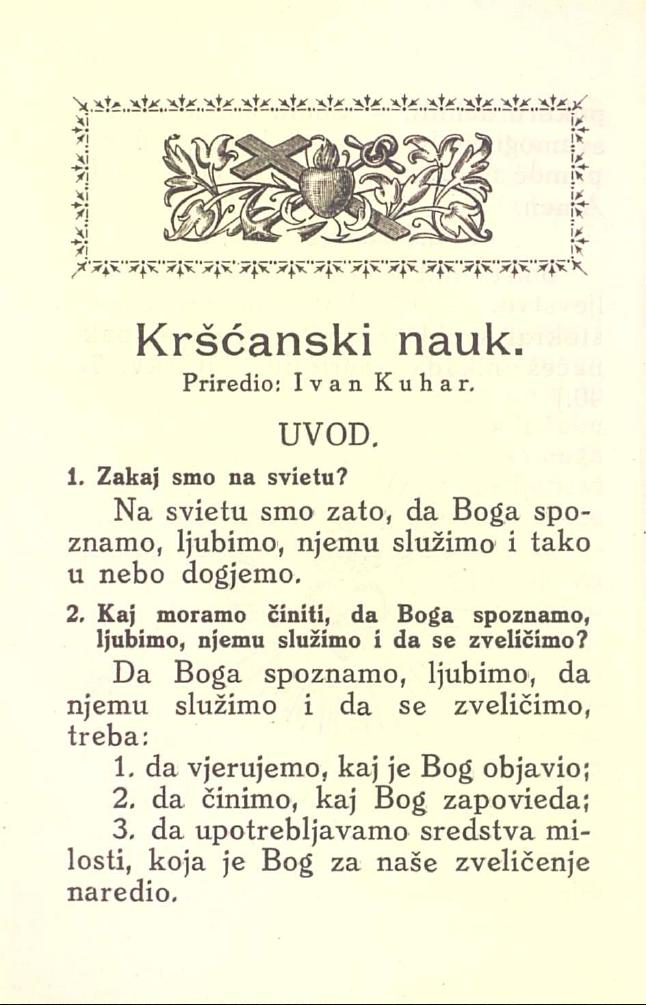
Saint #Sava the Enlightener (1174–1236) was a #Serbian prince and the first Archbishop of the Serbian #Orthodox Church. He's the patron saint of #Serbia.
#SaintSava (#СветиСава) is also regarded as the founder of Serbian #mediaeval #literature.
#SaintSava (#СветиСава) is also regarded as the founder of Serbian #mediaeval #literature.

Together with his father, #SaintSava founded the #Hilandar Monastery in #MountAthos, #Greece in 1198. It became a key centre of #Serbian culture and scholarship. The monastery's #library holds a trove of thousands of historical #Greek and #Slavic books and #manuscripts. 

One of the oldest #Slavic documents in the #Hilandar Monastery is the #KaryesTypikon, produced and signed by Saint #Sava in 1199. It's a #translation of a standard #Greek religious text. 

The #StudenicaTypikon was written by #SaintSava at the #Hilandar Monastery in 1208. It defines rules to govern monastic life and is considered the first constitution of the #Serbian #Orthodox Church. It also includes a biography of #Sava's father, Grand Prince Stefan #Nemanja. 
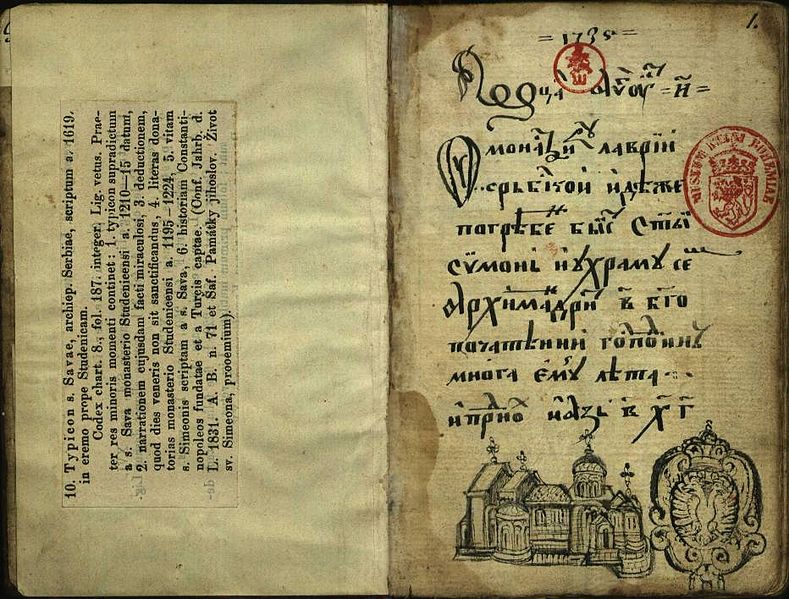
The #Nomocanon of #SaintSava (#Zakonopravilo) played a key part in securing the #Serbian #Orthodox Church's religious independence from #Constantinople in 1219.
#Sava wrote it in the #Shtokavian #dialect of #Serbia's #Raška region.
A 1262 copy:
[Image: en.wikipedia.org/wiki/File:Savi…]
#Sava wrote it in the #Shtokavian #dialect of #Serbia's #Raška region.
A 1262 copy:
[Image: en.wikipedia.org/wiki/File:Savi…]

The #Vinodol statute is one of the oldest #Slavic legal codes. It was written in 1288 in the town of #NoviVinodolski on the #Adriatic Sea coast of #Croatia.
Its #language is #Chakavian, using the #Glagolitic script.
This is a 16th-century copy:
Its #language is #Chakavian, using the #Glagolitic script.
This is a 16th-century copy:

Some of the early #Shtokavian texts from #Croatia, such as the #Vatican #Croatian Prayer Book created between 1380 and 1400, were #translations of earlier #Chakavian or #ChurchSlavonic works. 

As a cultural centre of the #Serbian Principality and of the Serbian Kingdom, the #Raška region helped to shape #mediaeval Serbian #literature.
The early-13th-century #Belgrade #Prophetologion was written using mainly #Rascian #orthography (spelling and writing style).
The early-13th-century #Belgrade #Prophetologion was written using mainly #Rascian #orthography (spelling and writing style).

#VukansGospel was created in the late 12th or early 13th century in the #mediaeval fortress of #Ras, one of #Raška's first capitals.
With more than 189 pages, it's one of the oldest preserved #Serbian books, written in #ChurchSlavonic using #Rascian #Cyrillic #orthography.
With more than 189 pages, it's one of the oldest preserved #Serbian books, written in #ChurchSlavonic using #Rascian #Cyrillic #orthography.

The #Istrian Demarcation, a 1325 legal document, was written in #Latin, #German, and 'hrvackim', an unusual term for #Croatian.
The 'Croatian' part is #Chakavian with some #ChurchSlavonic influence, written in #Glagolitic.
A later transcript:
[Image: en.wikipedia.org/wiki/File:Ista…]
The 'Croatian' part is #Chakavian with some #ChurchSlavonic influence, written in #Glagolitic.
A later transcript:
[Image: en.wikipedia.org/wiki/File:Ista…]

In 1349 King Stefan #Dušan of #Serbia enacted a new legal system known as #DušansCode. At least two dozen manuscripts of the code were made over the next few centuries.
This page from the 15th-century #Prizren transcription includes an intricate design above the #Cyrillic text.
This page from the 15th-century #Prizren transcription includes an intricate design above the #Cyrillic text.

#NovakDisislavić was a #mediaeval #Croatian knight and duke. In 1368 he wrote a #Catholic missal (mass book) in the Croatian recension of #ChurchSlavonic using the #Glagolitic script. The colophon (final page) contains verses written in #Chavakian. 

#RadoslavsGospel is a #Serbian manuscript created in 1429. Its artwork echoes #Byzantine #Greek traditions.
A few of its folios contain the scribe's autobiographical notes that describe the creation of the book and the lives and working methods of #mediaeval scribes.
A few of its folios contain the scribe's autobiographical notes that describe the creation of the book and the lives and working methods of #mediaeval scribes.

'The Life of Despot Stefan #Lazarević' is a biography of the #Serbian ruler, written in 1431 by Constantine of #Kostenets, a #Bulgarian scholar who lived in #Serbia. The highly descriptive text influenced other works of #mediaeval Serbian #literature.
A fresco of Despot Stefan:
A fresco of Despot Stefan:

The #PoljicaStatute is a 14th–15th century legal document from the #mediaeval Republic of #Poljica in modern-day #Croatia. It was written in a mixture of the #Chakavian and #Shtokavian #dialects, with numerous bits of #ChurchSlavonic. The script is #Bosnian #Cyrillic. 

Queen Catherine of #Bosnia died in 1478 in #Rome. Her original epitaph (destroyed in 1590) in the Basilica of St Mary of the Altar of Heaven was written in #Latin in the Latin script, and in #SerboCroatian in #Cyrillic — the only known Cyrillic inscription in #mediaeval Rome. 

The first printed #Croatian book, the 'Missale Romanum #Glagolitice', was written in 1483 in the Croatian recension of #ChurchSlavonic. Its use of the #Glagolitic script makes it the first #missal (mass book) in #Europe published in a non-#Latin script. 
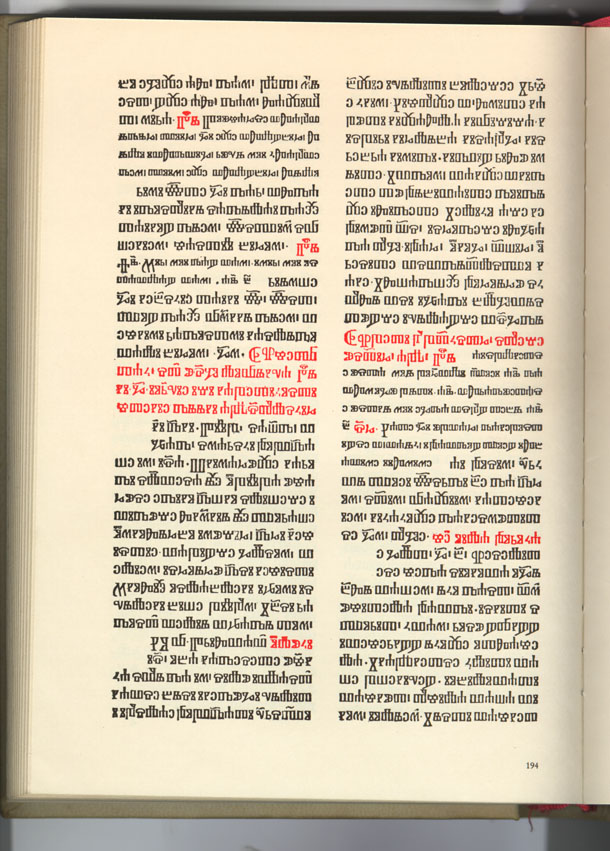
From 1484 to 1494, #Croatian priest #Martinac copied 500 folios of the #Glagolitic codex 'The Second Novi Vinodolski Breviary'. He filled gaps with his own writings, including the first Croatian patriotic poetry, which describes #Croatia's struggle against the #Ottoman Empire. 

In 1512 a printer named Frančesko #Micalović produced two books, '#Officio' (pictured below) and '#Molitvenik'. They were the first books to use the #Bosnian #Cyrillic script. Both were written in the #Shtokavian #dialect having been translated from #Chakavian. 
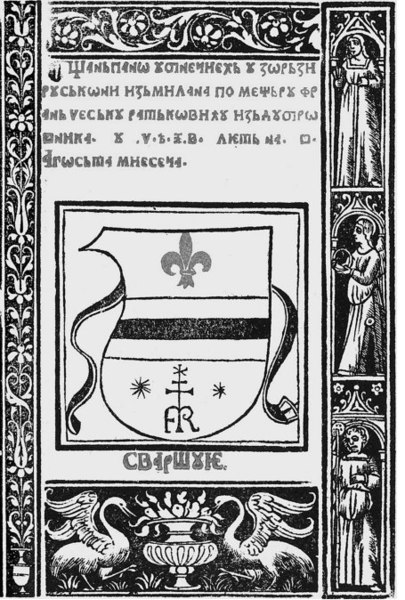
Marko #Marulić (1450 – 1524) was a #Croatian poet and #Renaissance #humanist who coined the word '#psychology'.
He wrote in #Latin, #Italian, and his mother tongue, #Chakavian, which he used to write #Judita, an epic poem about the #OldTestament heroine, #Judith.
1522 edition:
He wrote in #Latin, #Italian, and his mother tongue, #Chakavian, which he used to write #Judita, an epic poem about the #OldTestament heroine, #Judith.
1522 edition:

The early 15th-century #Manasija Monastery in #Serbia was the site of the #Resava #Literary School. Its library held more than 20,000 books. The #Cyrillic #orthography that developed at Resava became dominant in #Serbian #literature, surpassing the older #Raška style of writing. 

The #Goražde printing house (in present-day #BosniaAndHerzegovina) produced some of the earliest #Serbian printed works, including the 1521 #GoraždePsalter, which was written in the Serbian recension of #ChurchSlavonic using the #Resava #Literary School's #Cyrillic #orthography. 

In 1574 Ivanuš #Pergošić, an author from #Slavonia (in present-day #Croatia), wrote #Decretum, the first printed book in the #Kajkavian #dialect, which he referred to as '#Slavic'.
It's a #translation of #Tripartitum, a #Hungarian law book written in #Latin by István #Werbőczy.
It's a #translation of #Tripartitum, a #Hungarian law book written in #Latin by István #Werbőczy.

The #Arebica script was used in #BosniaAndHerzegovina from the 15th to the 20th century. It's based on the #PersoArabic script of the #Ottoman Empire, with a few additional letters not found in #Arabic, #Persian, or #Turkish.
Part of the song Chirvat-türkisi, circa 1588.
Part of the song Chirvat-türkisi, circa 1588.

Hasan Kafi #Pruščak (1544–1615), from the village of #Prusac in #BosniaAndHerzegovina, was a #Bosnian #Muslim scholar who used the #Arebica script to write some of #Bosnia's most significant works of the #Ottoman period.
Prusac fortress in 1897:
Prusac fortress in 1897:

Though written mainly in #Latin, this 1590 map of #Slavonia, Central #Croatia, #Bosnia, and part of #Dalmatia uses many local #Slavic (and some #German) place names.
It was created by #Flemish #cartographer Gerardus #Mercator (born Geert de Kremer) of #MercatorProjection fame.
It was created by #Flemish #cartographer Gerardus #Mercator (born Geert de Kremer) of #MercatorProjection fame.

Faust #Vrančić, known in #Italian as Fausto #Veranzio, was a #Croatian-#Venetian scholar from #Dalmatia (at the time, part of the #RepublicOfVenice).
In 1595 he published a five-#language #dictionary in #Latin, Italian, #German, '#Dalmatian' (mainly #Chakavian), and #Hungarian.
In 1595 he published a five-#language #dictionary in #Latin, Italian, #German, '#Dalmatian' (mainly #Chakavian), and #Hungarian.

Bartol #Kašić (1575–1650) was a #Jesuit clergyman from the island of #Pag in the #RepublicOfVenice (now #Croatia).
His native #dialect was #Chakavian, but he wrote mainly in #Shtokavian because it was the most common dialect among the South #Slavs of the western #Balkan region.
His native #dialect was #Chakavian, but he wrote mainly in #Shtokavian because it was the most common dialect among the South #Slavs of the western #Balkan region.

In 1599 #Kašić wrote an #Italian-#Shtokavian #dictionary titled 'Various #Slavic Compositions'.
In 1604 he wrote 'The Structure of the #Illyrian #Language in Two Books', a two-part Shtokavian #grammar book with elements of #Chakavian. It's perhaps the first Slavic grammar book.
In 1604 he wrote 'The Structure of the #Illyrian #Language in Two Books', a two-part Shtokavian #grammar book with elements of #Chakavian. It's perhaps the first Slavic grammar book.

Names for the different #dialects of #SerboCroatian have long been varied and somewhat fluid. In his 1622 #Bible #translation, #Kašić referred to his native #Chakavian as '#Dalmatian', and to the #Ijekavian variety of #Shtokavian as '#Dubrovnik'.
[Image: en.wikipedia.org/wiki/File:Pag_…]
[Image: en.wikipedia.org/wiki/File:Pag_…]

#Kašić previously referred to #SerboCroatian as '#Illyrian'.
It was also common for #Slavic writers to use #language names somewhat interchangeably. He referred to the #Shtokavian used in his 1640 'Roman Rite' as either 'our language' or '#Bosnian', even though he was #Croatian.
It was also common for #Slavic writers to use #language names somewhat interchangeably. He referred to the #Shtokavian used in his 1640 'Roman Rite' as either 'our language' or '#Bosnian', even though he was #Croatian.

Earlier in this thread we saw similar ambiguity when Georgi #Pulevski variously described himself as #Bulgarian, #Macedonian, or #Serbian.
#Micalović, who was from #Ragusa (now #Dubrovnik, #Croatia), referred to the #language in his works as 'Serbian'.
#Micalović, who was from #Ragusa (now #Dubrovnik, #Croatia), referred to the #language in his works as 'Serbian'.
https://twitter.com/linglore/status/1311398197324140546
Matija #Divković (1563–1631) is considered the founder of modern #literature in #BosniaAndHerzegovina. He was a #Bosnian #Franciscan who wrote several #Catholic works in #Shtokavian, including '#Christian Doctrine for the #Slavic People', printed in 1611 using #BosnianCyrillic. 

In 1631 #Bosniak writer Muhamed #Hevaji #Uskufi Bosnevi used the #Arebica script to write the first '#Bosnian-#Turkish' #dictionary. It's one of the earliest dictionaries of the Bosnian variety of #SerboCroatian. 

Giacomo #Micaglia was born in 1601 in #Peschici, #Apulia to a family of #Croatian origin. He called himself 'an #Italian of #Slavic #language', and interchangeably referred to his #SerboCroatian language as 'Croatian', '#Illyric', or '#Slovinian'.
[Image: en.wikipedia.org/wiki/File:Pesc…]
[Image: en.wikipedia.org/wiki/File:Pesc…]

In #Micaglia's 1649 #SerboCroatian-#Italian-#Latin #dictionary & #thesaurus, he explained that he chose the '#Bosnian' #dialect (meaning #Shtokavian) because: 'everyone says that the Bosnian #language is the most beautiful one'.
Bits of #Chakavian and #Kajkavian also appear.
Bits of #Chakavian and #Kajkavian also appear.

Juraj #Habdelić (1609–1678) was a #Croatian #Jesuit priest from the village of Staro Čiče.
In 1670 he wrote 'Dictionar ili reči slovenske' ('Dictionary or #Slavic words'), a #Kajkavian-#Latin #dictionary.
In 1670 he wrote 'Dictionar ili reči slovenske' ('Dictionary or #Slavic words'), a #Kajkavian-#Latin #dictionary.

Vuk #Karadžić (1787–1864) was a #Serbian #philologist and #linguist who reformed and standardised Serbian #orthography. In 1818 he published his 'Serbian #Dictionary' and finalised the Serbian #Cyrillic #alphabet, which was officially adopted in 1868 and is still used today. 

#Karadžić based the #Serbian #Cyrillic #alphabet on the sounds of the #Shtokavian #dialect spoken in Eastern #Herzegovina.
He omitted many of the old Cyrillic letters such as Ѣ (#yat) and Ѿ (#ot), and added five new ones: Љ, Њ, Ћ, Ђ, and Џ. He also added the #Latin letter Ј.
He omitted many of the old Cyrillic letters such as Ѣ (#yat) and Ѿ (#ot), and added five new ones: Љ, Њ, Ћ, Ђ, and Џ. He also added the #Latin letter Ј.

The #Serbian #Cyrillic letter #Љ (#lje) is pronounced like the ⟨ll⟩ in 'million'.
#Karadžić invented it for his 1818 #dictionary. It's now used in #SerboCroatian, #Macedonian, and #Itelmen, an endangered #Chukotko-#Kamchatkan #language spoken in #Russia's #Kamchatka Peninsula.
#Karadžić invented it for his 1818 #dictionary. It's now used in #SerboCroatian, #Macedonian, and #Itelmen, an endangered #Chukotko-#Kamchatkan #language spoken in #Russia's #Kamchatka Peninsula.

The #Serbian #Cyrillic letter #Њ (#nje) is another #Karadžić invention. It's pronounced like the ⟨ni⟩ in 'onion'.
Like #Љ, it's used in #SerboCroatian, #Macedonian, and #Itelmen. It's also used in #Udege, an endangered #Tungusic #language native to #Russia's Far East region.
Like #Љ, it's used in #SerboCroatian, #Macedonian, and #Itelmen. It's also used in #Udege, an endangered #Tungusic #language native to #Russia's Far East region.

The letter #Ћ (#tshe) is unique to the #SerbianCyrillic #alphabet. It's pronounced like the ⟨ch⟩ in 'chew'.
It was first used by #Serbian #linguist Dositej #Obradović (1739–1811) as a revival of the old #Cyrillic letter #Ꙉ (#djerv), and later popularised by Vuk #Karadžić.
It was first used by #Serbian #linguist Dositej #Obradović (1739–1811) as a revival of the old #Cyrillic letter #Ꙉ (#djerv), and later popularised by Vuk #Karadžić.

Lukijan #Mušicki (1777–1837) constructed the #Serbian #Cyrillic letter #Ђ (#dje) at #Karadžić's request. He designed it by modifying the form of the letter #Ћ.
The /dʑ/ sound that Ђ represents isn't used in #English. The /dʒ/ sound produced by the ⟨dj⟩ in 'adjust' comes close.
The /dʑ/ sound that Ђ represents isn't used in #English. The /dʒ/ sound produced by the ⟨dj⟩ in 'adjust' comes close.

In #Macedonian and #SerbianCyrillic, the letter #Џ (#dzhe or #gea) is pronounced like the English ⟨j⟩ in 'jug'. The letter is also used in the #Abkhaz #language to represent the slightly different /d͡ʐ/ sound.
Џ was first used in the 15th-century #Romanian #Cyrillic #alphabet.
Џ was first used in the 15th-century #Romanian #Cyrillic #alphabet.

#Linguist and folklorist Jacob #Grimm was the first to call the #language '#SerboCroatian'.
In 1824 Grimm translated a #Serbian #grammar book by his friend Vuk #Karadžić, adding his own scholarly introduction on #Slavic #languages and #literature.
In 1824 Grimm translated a #Serbian #grammar book by his friend Vuk #Karadžić, adding his own scholarly introduction on #Slavic #languages and #literature.

Ljudevit #Gaj (1809–1872) was a #German-#Croatian #linguist and a major figure in the pan-#Slavist '#Illyrian Movement'. He's best known for creating a standard #Latin-based #alphabet for Croatian writing in his 1830 book 'A Concise Basis of Croatian-#Slavonic Spelling'. 
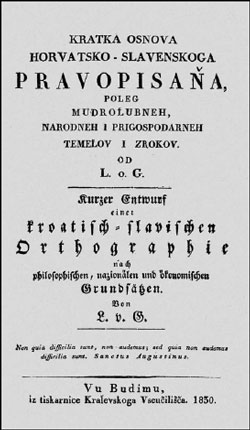
Like the #Czech #alphabet on which it's based, #Gaj's #Latin alphabet makes use of the wedge-shaped #caron (or #háček) #diacritic.
The alphabet's thirty letters include Č, Ć, Dž, Đ, Lj, Nj, Š, and Ž. The Latin letters Q, W, X, and Y are omitted.
[Image: en.wikipedia.org/wiki/File:SrbL…]
The alphabet's thirty letters include Č, Ć, Dž, Đ, Lj, Nj, Š, and Ž. The Latin letters Q, W, X, and Y are omitted.
[Image: en.wikipedia.org/wiki/File:SrbL…]

#Gaj's #Latin #alphabet eventually spread from #Croatia to other #SerboCroatian speaking areas.
It also influenced the #alphabets of the #Vlax and #BalkanRomani #dialects of #Romani, and became the basis of the #Slovene and #BanatBulgarian alphabets.
It also influenced the #alphabets of the #Vlax and #BalkanRomani #dialects of #Romani, and became the basis of the #Slovene and #BanatBulgarian alphabets.
https://twitter.com/linglore/status/1251048029077020673
In the 1830s Ljudevit #Gaj urged all #Croats to write in #Shtokavian, in part because it's the only #SerboCroatian #dialect that's also spoken by #Serbs and #Bosnians, with whom he sought to cultivate a pan-Slavist link. (#Chakavian and #Kajkavian are spoken primarily by Croats.) 

The 'Bosnian Book of the Science of Conduct' is a religious work written in the #Arebica script. It was published in 1831, ten years after its author, poet Abdulvehab #Ilhamija #Žepčevi, was executed for criticising the #Ottoman Empire's harsh rule over the #Bosnian people. 

Ignac #Kristijanović (1796–1884) was a #Croatian priest who translated works from the #Bible and #Aesop's fables into #Kajkavian. He opposed the pan-#Slavist #Illyrian movement's promotion of #Shtokavian over the other two #dialects.
A Kajkavian calendar edited by Kristijanović:
A Kajkavian calendar edited by Kristijanović:

#Croatian and #Serbian writers (including Vuk #Karadžić) met in #Vienna in 1850 to agree a common standard for #SerboCroatian based on #Shtokavian. Though not official, their work influenced later official acts, including #Serbia's 1868 #language reform.
https://twitter.com/linglore/status/1327349273390931976
The Serbian #Slavist Đuro #Daničić (1825–1882) was a signatory to the 1850 #ViennaLiteraryAgreement. He regarded #Croatian and #Serbian literature as parts of the same body of #literature.
The first volume of Daničić's 1882 '#Dictionary of Croatian or Serbian #Language':
The first volume of Daničić's 1882 '#Dictionary of Croatian or Serbian #Language':

The National Printing House (originally Sopron’s Publishing House), was founded in #Sarajevo, #Bosnia in 1866. It printed books in the #Latin, #Cyrillic, #Hebrew, and #Arabic scripts.
The 1890 '#Bosnian #Grammar for High Schools' was printed in both Latin and Cyrillic letters.
The 1890 '#Bosnian #Grammar for High Schools' was printed in both Latin and Cyrillic letters.

Tomislav #Maretić (1854–1938) led the #Croatian #Vukovians, a group of #linguists in the late 19th and early 20th centuries who worked to standardise the Croatian variety of #SerboCroatian using the same #Shtokavian #dialect that Vuk #Karadžić used for the #Serbian standard. 

The #Croatian #Vukovians based their #orthography on the #language's #phonology (sounds), unlike the earlier #Zagreb #Philological School led by Adolfo #Veber #Tkalčević (1825–1889), who used traditional #morphology (word structure). The Vukovians' approach eventually prevailed. 
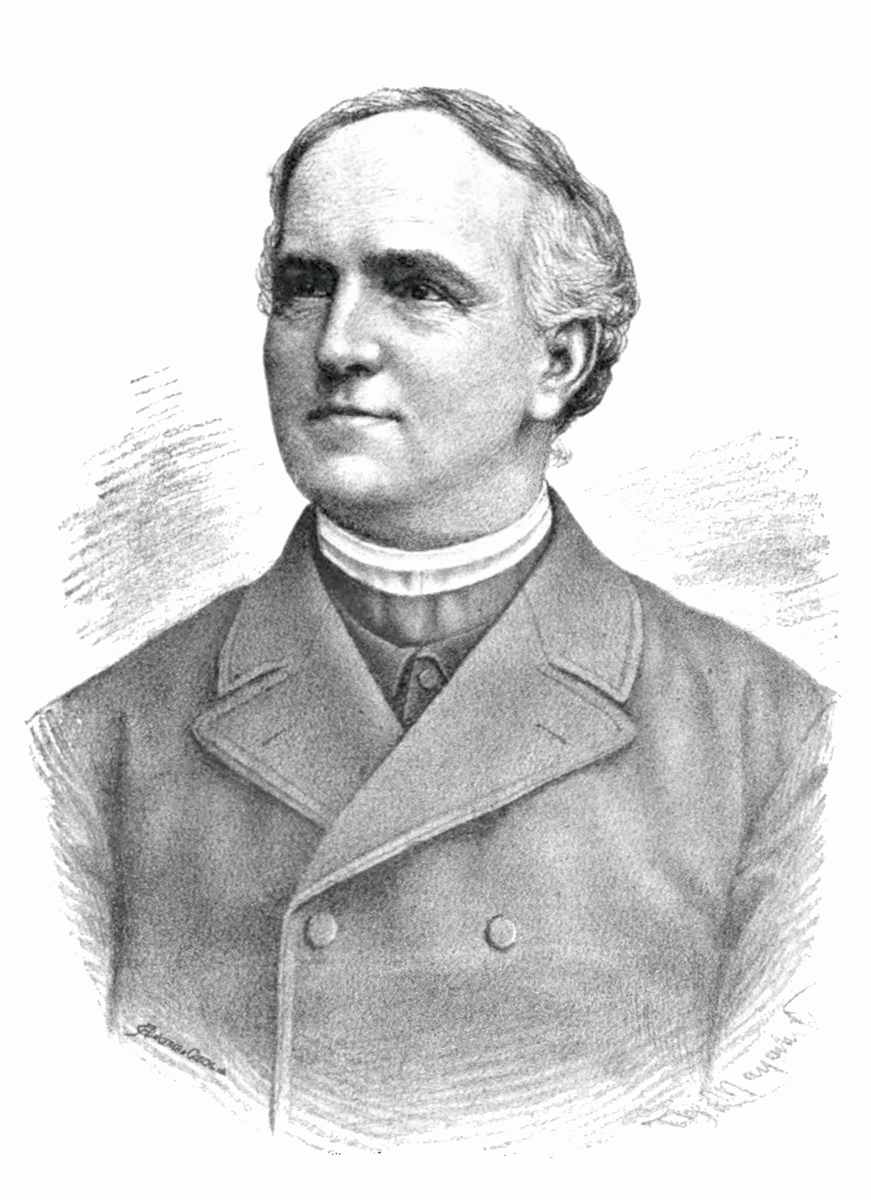
The works published by the #Croatian #Vukovians, including Tomislav #Maretić's 1899 '#Grammar and Stylistics of the Croatian or #Serbian #Literary #Language', strongly influenced the way #SerboCroatian was written and later standardised, especially in #Croatia. 

The 1892 '#Croatian #Orthography' by Ivan #Broz (1852–1893) had the greatest impact on future standards of written Croatian. Broz was less radical than his fellow Croatian #Vukovians, opting for more continuity with earlier traditions. This made his standard easier to adopt. 

Safvet-beg #Bašagić (1870–1934) was a #Bosnian writer, poet, journalist, translator, and politician. His unique collection of 12th- to 19th-century manuscripts includes #Arabic, #Persian, and #Turkish works, and rare #Croatian and #Serbian texts written in the Arabic script. 

Mehmed Džemaludin #Čaušević (1870–1938) was a #Bosniak imam, #Muslim reformer, and #Arabic teacher. In the late 19th century he devised #Matufovica, the final version of the #Arebica #alphabet. In the 1930s he translated the #Quran into the #Bosnian variety of #SerboCroatian. 

The Kingdom of the #Serbs, #Croats, and #Slovenes (colloquially called '#Yugoslavia') was established in 1918.
Its official #language, referred to as 'Serbo-Croato-Slovenian' in the 1921 constitution, was based on the standards defined by #Karadžić and the #Illyrian movement.
Its official #language, referred to as 'Serbo-Croato-Slovenian' in the 1921 constitution, was based on the standards defined by #Karadžić and the #Illyrian movement.

King Alexander I changed the country's official name to 'Kingdom of #Yugoslavia' in 1929. A new constitution in 1931 identified 'Serbo-Croato-Slovene' as the kingdom's official #language. 
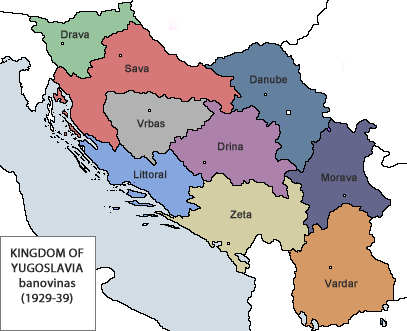
During #WWII the Axis powers set up a nationalist Croatian puppet state that oppressed Jews, Roma, and #Serbs, as well as #Croats with a pan-#Slavist or #Yugoslav inclination.
Authorities closed #Serbian schools and purged the '#Croatian' #language of 'Eastern' (Serbian) words.
Authorities closed #Serbian schools and purged the '#Croatian' #language of 'Eastern' (Serbian) words.

The post-war Communist rulers of #Yugoslavia didn't decree an official state #language. However, as the language of three quarters of the population, #SerboCroatian naturally predominated.
Local regions liberally granted official status to minority #languages such as #Romanian.
Local regions liberally granted official status to minority #languages such as #Romanian.

#Yugoslav writers and #linguists met in #NoviSad in 1954 to issue an agreement that #SerboCroatian was a single #language that developed around two main centres (#Belgrade and #Zagreb), and that the #Latin and #Cyrillic scripts are equal and should therefore be learned by all. 

Despite #Yugoslavia's equitable #language policy, some Croatian scholars alleged a pro-Serbian bias. In 1967, they signed a declaration (perhaps written by State Security agents) calling for separate 'national' standards for #Serbian, #Croatian, #Slovene, and #Macedonian. 

Facing growing support for the 'national' rights of its constituent republics, #Yugoslavia adopted a new constitution in 1974 that maximised local autonomy and essentially met the 1967 declaration's demands for separate #language standards. 

The 1990s and early 2000s were a time of horrific wars, ethnic conflicts, and the fragmentation of #Yugoslavia into several independent states.
Four varieties of #SerboCroatian (#Serbian, #Croatian, #Bosnian, and #Montenegrin) gained official status in their respective areas.
Four varieties of #SerboCroatian (#Serbian, #Croatian, #Bosnian, and #Montenegrin) gained official status in their respective areas.

While officially treated as separate #languages, #Serbian, #Croatian, #Bosnian, and #Montenegrin are linguistically barely distinguishable, having all been based on the same Eastern Herzegovinian #dialect of #Shtokavian. A speaker of any of them fully understands all four. 

With roughly 12M speakers, #Serbian is the most widely-spoken official variety of #SerboCroatian. It's #Serbia's official #language, and a recognised minority language in #Croatia, #NorthMacedonia, #Romania, #Hungary, #Slovakia, and #Czechia. 

The 1995 #DaytonAccords ended the war in #Bosnia and established two political entities within the country: one populated mainly by #Croats and #Bosniaks, and the other mainly by #Serbs. Both entities were required to make #Serbian, #Croatian, and #Bosnian co-official #languages. 

While #Serbian holds official status in both of #Bosnia's political entities, it's of course in the #Serb-dominated #RepublikaSrpska where its daily use is more common. Republika #Srpska authorities encourage the use of the Serbian #Cyrillic #alphabet instead of the Latin script. 
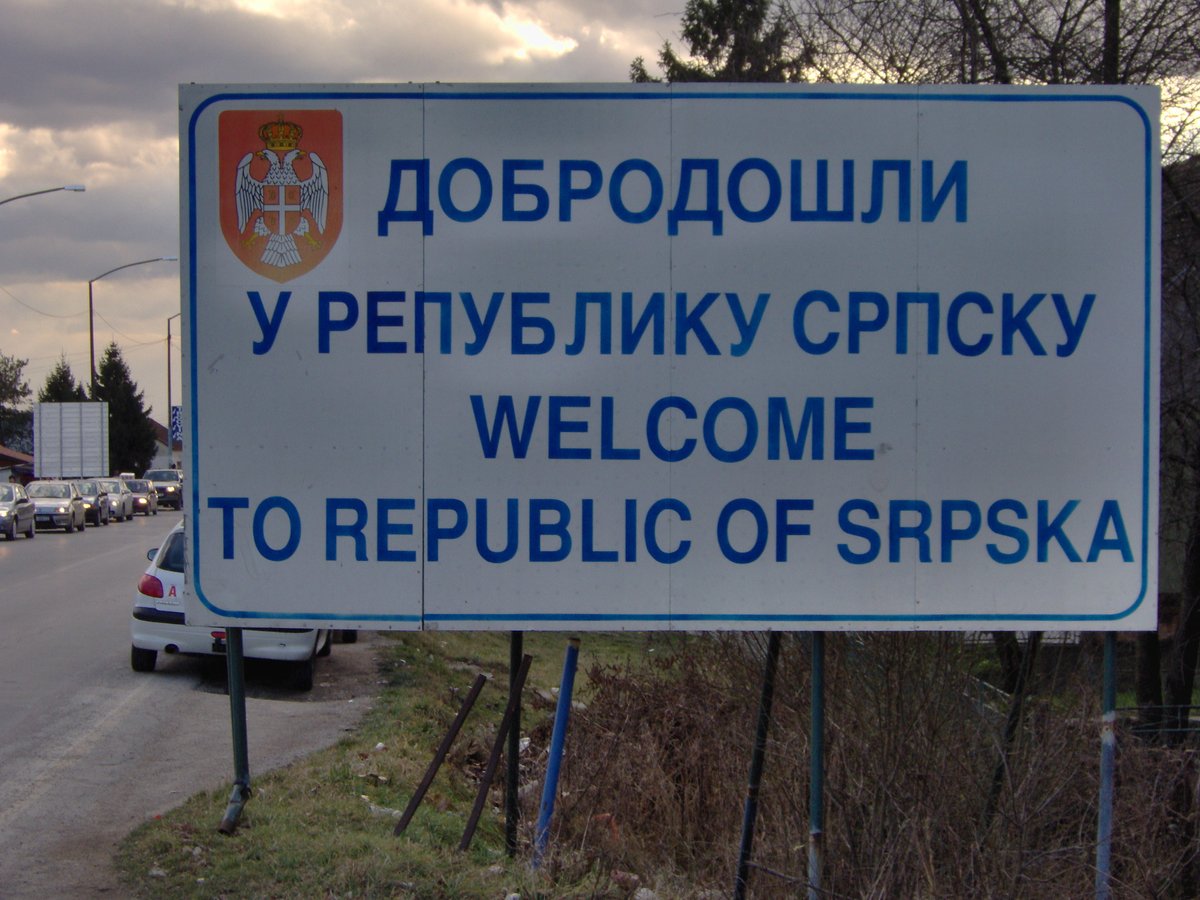
#Serbs are the largest national minority in #Croatia, constituting more than 4% of the population. #Serbian is a co-official minority #language in at least twenty of the country's municipalities (dark green on map).
[Image: en.wikipedia.org/wiki/File:Serb…]
[Image: en.wikipedia.org/wiki/File:Serb…]

After #Albanians, #Serbs form the second largest ethnic group in #Kosovo, which declared independence from #Serbia in 2008. Serbs make up perhaps 5% to 7% of the 1.9M population. (Most Serbs boycotted the 2011 census.)
#Albanian and #Serbian are co-official #languages.
#Albanian and #Serbian are co-official #languages.

Western #Romania is home to some 18K ethnic #Serbs.
In the rural commune of #Socol near the #Danube, almost 53% of the 1.9K population is Serbian. Socol (called #Sokol in Serbian, and Sakalovez on this circa 1772 map) uses both #Romanian and #Serbian for all official purposes.
In the rural commune of #Socol near the #Danube, almost 53% of the 1.9K population is Serbian. Socol (called #Sokol in Serbian, and Sakalovez on this circa 1772 map) uses both #Romanian and #Serbian for all official purposes.

Beginning in the 14th century with the #Ottoman conquest of #Serbia, large numbers of #Serbs migrated to #Hungary.
Over the course of the 20th century, the migration reversed. The number of #Serbian speakers in Hungary decreased from more than 26K in 1910 to around 7K today.
Over the course of the 20th century, the migration reversed. The number of #Serbian speakers in Hungary decreased from more than 26K in 1910 to around 7K today.

Around 300K in number, #Serbs are #Austria's second largest ethnic group after #Germans. #Serbian is the native #language of ~2.2% of the population, coming in third after #German and #Turkish.
Self-portrait of #Viennese-Serbian writer and artist Mina #Karadžić (Vuk's daughter):
Self-portrait of #Viennese-Serbian writer and artist Mina #Karadžić (Vuk's daughter):

#Trieste, #Italy has had an ethnic #Serb minority since the 18th century. Its numbers swelled during and after the #Yugoslav Wars of the 1990s. More foreign-born residents of Trieste come from #Serbia than any other country. Most assimilate into the #Italian-speaking community. 

Most #programming #languages, including C++, use keywords from #English: for, while, if, switch, etc.
Ћ++ (#Ћплусплус) is a #JavaScript-based programming #language that uses #Serbian keywords written in the #Cyrillic script.
Ћ++ (#Ћплусплус) is a #JavaScript-based programming #language that uses #Serbian keywords written in the #Cyrillic script.

#Bosnian has 2.5M to 3M speakers, mostly #Bosniaks. It's one of the four official varieties of #SerboCroatian, with some loanwords from #Ottoman #Turkish, #Persian, and #Arabic. It has official or recognised status in #Bosnia, #Serbia, #Montenegro, #NorthMacedonia, and #Kosovo. 

Some Bosnian #Croats and #Serbs reject the name 'Bosnian language', arguing it implies that it's the #language of all #Bosnians. #RepublikaSrpska's constitution calls it the 'Language spoken by Bosniaks'.
#Bosniaks insist on the name '#Bosnian language'.
#Bosniaks insist on the name '#Bosnian language'.
https://twitter.com/linglore/status/1355839948662960135
#Bosniaks, #Serbs, and #Croats in the ethnically-mixed #Brčko District tend to mingle more than in other parts of #Bosnia. However, when it comes to #language education, pupils are still divided along ethnic lines into separate classes for #Bosnian, #Serbian, and #Croatian. 

#Borak (#Borakja / #Borakë) is an entirely #Bosnian-speaking village in #Albania's #Durrës District. Christian uprisings against the #Ottoman Empire in the 1870s caused #Bosniaks from the #Mostar area in #Herzegovina to flee to Durrës and the surrounding towns and villages. 

Among the four official varieties of #SerboCroatian, Montenegrin has the fewest speakers. It's also the newest variety: the movement to recognise #Montenegrin as a distinct #language emerged only in 2004. #Montenegro's 2007 constitution made it the country's official language. 
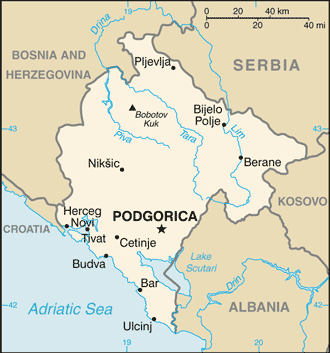
#Montenegro's official #language changed from #SerboCroatian to #Serbian in 1992, and to #Montenegrin in 2007. Much of the population, including many ethnic #Serbs and some ethnic #Montenegrins, still regard Serbian as their native language.
[Image: en.wikipedia.org/wiki/File:Mont…]
[Image: en.wikipedia.org/wiki/File:Mont…]

The Latin and Cyrillic scripts hold equal official status in #Montenegro. Most #Montenegrin speakers use the #Latin one.
Since 2009 the #MontenegrinAlphabet includes all the letters of the #Serbian #alphabet plus two: Ś and Ź (#Cyrillic С́ and З́).
Since 2009 the #MontenegrinAlphabet includes all the letters of the #Serbian #alphabet plus two: Ś and Ź (#Cyrillic С́ and З́).
https://twitter.com/linglore/status/1328725118961455105
After World War II a group of #Montenegrins migrated to the village of #Sekić in #Vojvodina (northern #Serbia) and renamed it #Lovćenac after Mount #Lovćen in #Montenegro. The municipality of Mali Iđoš, which includes Lovćenac, recognises #Montenegrin as a minority #language. 

Like #Serbian, #Bosnian, and #Croatian, standard #Montenegrin is based on the #EasternHerzegovinian #dialect of #Shtokavian (yellow on map).
A different Shtokavian dialect, #ZetaRaška, is spoken in southern and eastern #Montenegro (red / pink).
[Image: en.wikipedia.org/wiki/File:Mont…]
A different Shtokavian dialect, #ZetaRaška, is spoken in southern and eastern #Montenegro (red / pink).
[Image: en.wikipedia.org/wiki/File:Mont…]
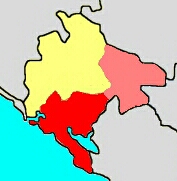
#ZetaRaška-speaking migrants from #Montenegro repopulated the village of Peroj in #Istria, #Croatia in the mid 17th century after disease had nearly eliminated an earlier #Cypriot community.
Most residents of #Peroj use the #Cyrillic script.
[Image: commons.wikimedia.org/wiki/File:Pero…]
Most residents of #Peroj use the #Cyrillic script.
[Image: commons.wikimedia.org/wiki/File:Pero…]
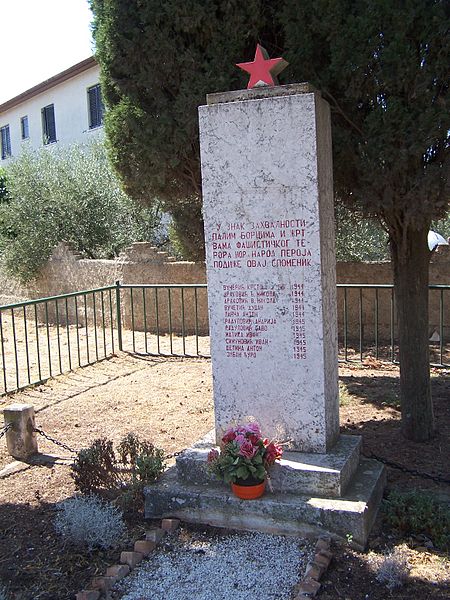
With more than 5M speakers, Croatian is the second-largest official variety of #SerboCroatian. It's the official #language of #Croatia and one of the official #languages of the #EuropeanUnion.
#Croatian is written using #Gaj's #Latin #alphabet.
#Croatian is written using #Gaj's #Latin #alphabet.
https://twitter.com/linglore/status/1335189136668459009
#Croats are the third most populous ethnic group in #BosniaAndHerzegovina. #Croatian is an official #language of both of the country's political entities, but is spoken primarily in the Federation of #Bosnia and #Herzegovina, where more than 91% of #BosnianCroats live. 

Around 58K #Croats live in #Serbia, 47K of whom live in the autonomous province of Vojvodina (the northernmost province), where they make up 2.78% of the population. #Croatian is one of six official #languages in #Vojvodina.
[Image: en.wikipedia.org/wiki/File:Vojv…]
[Image: en.wikipedia.org/wiki/File:Vojv…]

About ⅔ of all #Croats in #Vojvodina belong to the #Bunjevci or #Šokci ethnic groups, most of whose members identify as #Croatian.
In March 2021 the city assembly of #Subotica voted to make #Bunjevac, the Bunjevci people's #Shtokavian #dialect, one of its official #languages.
In March 2021 the city assembly of #Subotica voted to make #Bunjevac, the Bunjevci people's #Shtokavian #dialect, one of its official #languages.

The #Šokci people are an ethnic group native to eastern #Croatia, southwestern #Hungary, and northern #Serbia. Most identify as #Croats.
Šokac, a #Shtokavian #dialect, is spoken almost exclusively by Šokci.
The Catholic church in #Sonta, a majority #Šokac village in #Vojvodina:
Šokac, a #Shtokavian #dialect, is spoken almost exclusively by Šokci.
The Catholic church in #Sonta, a majority #Šokac village in #Vojvodina:

The historical region of #Baranya (#Baranja) spans present-day #Croatia and #Hungary. Baranya County in Hungary is home to more than 6K #Croats, many of them Catholic #BosnianCroats (known as #Bošnjaci in #Croatian) whose ancestors migrated to Baranya around the 18th century. 

Standard #Croatian is based on #Shtokavian. #Chakavian and #Kajkavian are still common in their respective parts of #Croatia.
The three #dialects have limited mutual intelligibility. Kajkavian is closer to #Slovene than it is to the other two.
[Image: en.wikipedia.org/wiki/File:Croa…]
The three #dialects have limited mutual intelligibility. Kajkavian is closer to #Slovene than it is to the other two.
[Image: en.wikipedia.org/wiki/File:Croa…]

The #WhiteCarniola (#BelaKrajina in #Slovene) region in southeastern #Slovenia borders #Croatia and shares cultural and #linguistic features with the #Kajkavian-speaking areas of Croatia.
It's also home to #Shtokavian-speaking #Serbs whose ancestors fled the #Ottoman conquest.
It's also home to #Shtokavian-speaking #Serbs whose ancestors fled the #Ottoman conquest.

During the #Ottoman conquest many #Croats fled to the #Austrian state of #Burgenland and to nearby parts of #Hungary and #Slovakia. Around 60K of their descendants speak #BurgenlandCroatian, a #Chakavian #dialect with elements of #Shtokavian, #Kajkavian, #German, and #Hungarian. 

#Slavomolisano (#MoliseSlavic / #MoliseCroatian) is a variety of #Shtokavian with strong #Chakavian influence. It's spoken in the #Campobasso province of #Molise, #Italy by fewer than 1,000 people, descendants of #Croats who fled the 16th-century #Ottoman invasion of #Dalmatia. 

For centuries #SerboCroatian-speaking migrants have helped spread elements of #Slavic culture far and wide.
In 1893 #Serbs in #Juneau, #Alaska joined the effort of the #Indigenous #RussianOrthodox #Tlingit community to build an #Orthodox church.
[Image: en.wikipedia.org/wiki/File:Sain…]
In 1893 #Serbs in #Juneau, #Alaska joined the effort of the #Indigenous #RussianOrthodox #Tlingit community to build an #Orthodox church.
[Image: en.wikipedia.org/wiki/File:Sain…]

More than 100K ethnic #Croats live in #Chile, where #SerboCroatian-#language newspapers were published in the early 20th century. #Croatian #Chileans have since assimilated into the #Spanish-speaking population.
19th-century advertisement for a Croatian cruiser to #SouthAmerica:
19th-century advertisement for a Croatian cruiser to #SouthAmerica:

A series of conferences in #Montenegro, #Croatia, #Serbia, and #Bosnia led to the 2017 Declaration on the Common Language, stating that #Croats, #Bosniaks, #Serbs and #Montenegrins have a common polycentric #language, challenging official policies that emphasise differences. 

'#Bosnian-#Croatian-#Montenegrin-#Serbian' (#BCMS) is gaining ground as a more inclusive and neutral name for the South #Slavic #language. However, at present #SerboCroatian remains the more familiar name to most people outside the #Balkan peninsula.
https://twitter.com/linglore/status/1292190775988690947
#SlavonicSerbian was a literary #language based on #Shtokavian, #Russian, and the Russian recension of #ChurchSlavonic. It was used by #Serbs in #Vojvodina during the 18th and early 19th centuries.
Its first printed work was the 1768 Slaveno-Serbski Magazin by Zaharije #Orfelin.
Its first printed work was the 1768 Slaveno-Serbski Magazin by Zaharije #Orfelin.

Teodor #Avramović adapted a 1784 #Russian–#German dictionary to create his own #dictionary in 1791 that translates between #German, printed in the Latin script using a #Fraktur typeface, and #SlavonicSerbian, printed in #Cyrillic.
Part two, titled 'Slavonic-Serbian Lexicon':
Part two, titled 'Slavonic-Serbian Lexicon':

Slovene has 2.5M speakers, mostly in #Slovenia and nearby parts of #Italy, #Austria, and #Hungary. It belongs to the Western sub-group of the South #Slavic #languages. Its closest relative is the #Kajkavian #dialect of #SerboCroatian.
#Slovene is written using the Latin script.
#Slovene is written using the Latin script.

The #Slavic ancestors of modern #Slovenes arrived in the eastern #Alps around the 6th century, initially living under the rule of the #PannonianAvars.
A few Slovene proper nouns have (#Turkic) #Avar origins, such as #Kajzaze, the #Slovene name for #Edling, a village in #Austria.
A few Slovene proper nouns have (#Turkic) #Avar origins, such as #Kajzaze, the #Slovene name for #Edling, a village in #Austria.

The ancient #Celtic #Carni people lived in #Carnia in the eastern #Alps.
#Slavs who inhabited the area in the Early #MiddleAges became known as #Carantanians.
The region names #Carniola (#Kranjska) in #Slovenia and #Carinthia (#Kärnten) in #Austria ultimately derive from Carni.
#Slavs who inhabited the area in the Early #MiddleAges became known as #Carantanians.
The region names #Carniola (#Kranjska) in #Slovenia and #Carinthia (#Kärnten) in #Austria ultimately derive from Carni.

The #Carantanians' #language (called #AlpineSlavic by some scholars) was presumably close to #ProtoSlavic. Early recorded names reveal heavy #WestSlavic influence. From the 8th century onwards, Alpine #Slavic gradually underwent changes typical of other #SouthSlavic #languages. 

The #FreisingManuscripts were written around 1000 CE in a language that was transitional between #AlpineSlavic and its descendant, #Slovene.
Inscribed in a calligraphic style called #Carolingian miniscule, they're the first Latin-script documents in any #Slavic #language.
Inscribed in a calligraphic style called #Carolingian miniscule, they're the first Latin-script documents in any #Slavic #language.

Between the 9th and 12th centuries, the #mediaeval #Slavic #language that would soon develop into Slovene spread to the area around #Trieste and northern #Istria.
#Osp, one of the oldest villages in #Slovenia, and the first in the #Istrian peninsula to have a #Slovene school:
#Osp, one of the oldest villages in #Slovenia, and the first in the #Istrian peninsula to have a #Slovene school:

By around the 13th century, #AlpineSlavic had evolved into #Slovene, a #language that was spoken across much of present-day #Austria.
Many places there bear #Slavic-derived names. #Göriach, in the state of #Salzburg, comes from 'gora' (mountain).
[Image: de.wikipedia.org/wiki/G%C3%B6ri…]
Many places there bear #Slavic-derived names. #Göriach, in the state of #Salzburg, comes from 'gora' (mountain).
[Image: de.wikipedia.org/wiki/G%C3%B6ri…]

The term 'Slovene lands' denotes territories where people primarily spoke Slovene.
Two gradual waves of Germanisation — one before the 15th century; another beginning in the 19th — majorly reduced the northern #Slovene-speaking area.
1848 'Map of Slovene Land and Provinces':
Two gradual waves of Germanisation — one before the 15th century; another beginning in the 19th — majorly reduced the northern #Slovene-speaking area.
1848 'Map of Slovene Land and Provinces':

This 1515 German pamphlet about the Slovene Peasant Revolt contains the first printed #Slovene words: 'stara pravda' (old rights).
Around 80K rebels fought for the restoration of their previously-held trade rights for five months before #German mercenaries quashed the rebellion.
Around 80K rebels fought for the restoration of their previously-held trade rights for five months before #German mercenaries quashed the rebellion.

In 1550 Primož #Trubar wrote Abecedarium and Catechismus, the first printed #Slovene book.
He natively spoke a Lower #Carniolan #dialect from the village of #Rašica. However, he based his writing mainly on #Ljubljana's variety of the #language.
First page of #Catechismus:
He natively spoke a Lower #Carniolan #dialect from the village of #Rašica. However, he based his writing mainly on #Ljubljana's variety of the #language.
First page of #Catechismus:

The title line of #Trubar's book appears in German. It includes the description 'in der Windischen Sprach' (in the Windisch #language).
Until the 19th century, the only name for #Slovene in German was the (now obsolete) term '#Windisch'. Today #German speakers use '#Slowenisch'.
Until the 19th century, the only name for #Slovene in German was the (now obsolete) term '#Windisch'. Today #German speakers use '#Slowenisch'.

In 1584 Adam #Bohorič published the first #grammar book for the Slovene #language: 'Arcticae horulae succisivae'. (He wrote it in #Latin.)
In it, he codified the writing system first used by Primož #Trubar. Now known as the #BohoričAlphabet, it was the first #Slovene #alphabet.
In it, he codified the writing system first used by Primož #Trubar. Now known as the #BohoričAlphabet, it was the first #Slovene #alphabet.

In his 1550 book, Primož #Trubar based the earliest form of the #BohoričAlphabet on the Latin script used for #German.
#Slovene #linguist and theologian Sebastian #Krelj further developed and reformed the #alphabet in his 1566 'Children's Bible'.
#Slovene #linguist and theologian Sebastian #Krelj further developed and reformed the #alphabet in his 1566 'Children's Bible'.

The final form of the #BohoričAlphabet codified in Adam #Bohorič's 1584 book had 25 letters and digraphs:
a b d e f g h i j k l m n o p r ſ ſh s sh t u v z zh
This #alphabet was used for Slovene until the 1840s.
A 1750 sample in #Styrian #Slovene with #Kajkavian influence:
a b d e f g h i j k l m n o p r ſ ſh s sh t u v z zh
This #alphabet was used for Slovene until the 1840s.
A 1750 sample in #Styrian #Slovene with #Kajkavian influence:
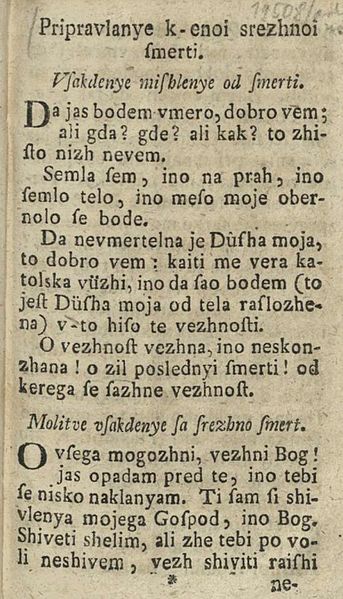
Lutheran minister Jurij #Dalmatin used the #Bohorič #alphabet to write his religious books, including the first complete translation of the Bible into Slovene, published in 1584. His work set the de facto standard for written #Slovene that prevailed until the early 19th century. 

Bishop Thomas #Chrön (Tomaž #Hren) was a leader of the Counter-Reformation.
In the early 1600s he persecuted Protestants and destroyed many Slovene Protestant books. However, he preserved #Dalmatin's Bible for use by Catholics, who had no #Slovene-#language Bible of their own.
In the early 1600s he persecuted Protestants and destroyed many Slovene Protestant books. However, he preserved #Dalmatin's Bible for use by Catholics, who had no #Slovene-#language Bible of their own.
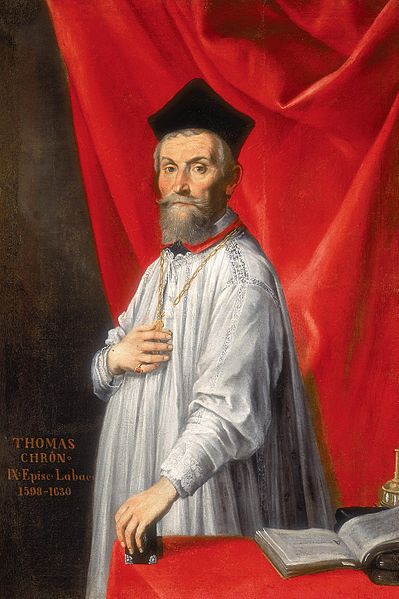
His zealous destruction of #Slovene-#language Protestant books aside, #Chrön did recognise the need for religious instruction in the vernacular. He funded the publication of Catholic priest Johannes #Tschandek's 1612 text 'Gospels and Epistles', based on Dalmatin's Bible. 

The oppressive acts of the Counter Reformation — including the destruction of books, the closure of Protestant schools, and Emperor Ferdinand's 1628 expulsion of nobles who refused to renounce the Protestant faith — slowed the development of #Slovene as a literary #language. 

16th-century Protestant texts in Slovene were typically created for public consumption.
Written #Slovene in the 17th century (after the Counter-Reformation) became rarer, and was usually created by and for Catholic clergy, such as this translation by a priest called Adam Skalar:
Written #Slovene in the 17th century (after the Counter-Reformation) became rarer, and was usually created by and for Catholic clergy, such as this translation by a priest called Adam Skalar:
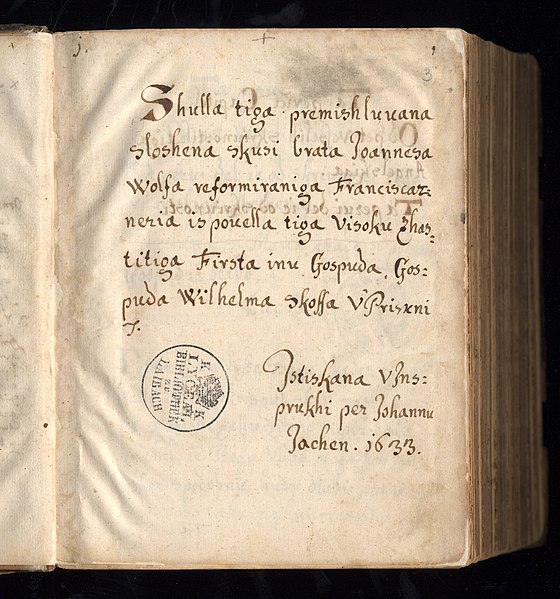
#TobiaLionelli was a Slovene–#Italian preacher who wrote a series of books entitled Sacrum Promptuarium between 1691 and 1707.
He wrote in the #Brda #dialect of #Slovene (from the present-day border area of #Italy and #Slovenia), and made ample use of #German and #Latin.
He wrote in the #Brda #dialect of #Slovene (from the present-day border area of #Italy and #Slovenia), and made ample use of #German and #Latin.

Matija #Kastelec was a Catholic priest, writer, and translator who wrote 'Dictionarium latino-carniolicum' in 1680. The #Latin–#Slovene #dictionary included vocabulary from a variety of Slovene #dialects, and became the basis for some other Slovene dictionaries that followed. 

In 1712 Janez Adam Geiger (also known as Hipolit Novomeški) drew on #Kastelec's work for his own trilingual #dictionary of #Latin, #German, and #Slovene.
In 1715 he published revised editions of #Tschandek's 'Gospels and Epistles' and #Bohorič's grammar.
In 1715 he published revised editions of #Tschandek's 'Gospels and Epistles' and #Bohorič's grammar.
https://twitter.com/linglore/status/1398010842826870787
The 'Škofja Loka Passion Play', which features stories about Jesus, is the oldest preserved play in the #Slovene #language.
A Capuchin monk called Romuald #Štandreški (born Lovrenc Marusič) wrote it in 1715, based on an older tradition.
#ŠkofjaLoka is a town in Upper #Carniola.
A Capuchin monk called Romuald #Štandreški (born Lovrenc Marusič) wrote it in 1715, based on an older tradition.
#ŠkofjaLoka is a town in Upper #Carniola.
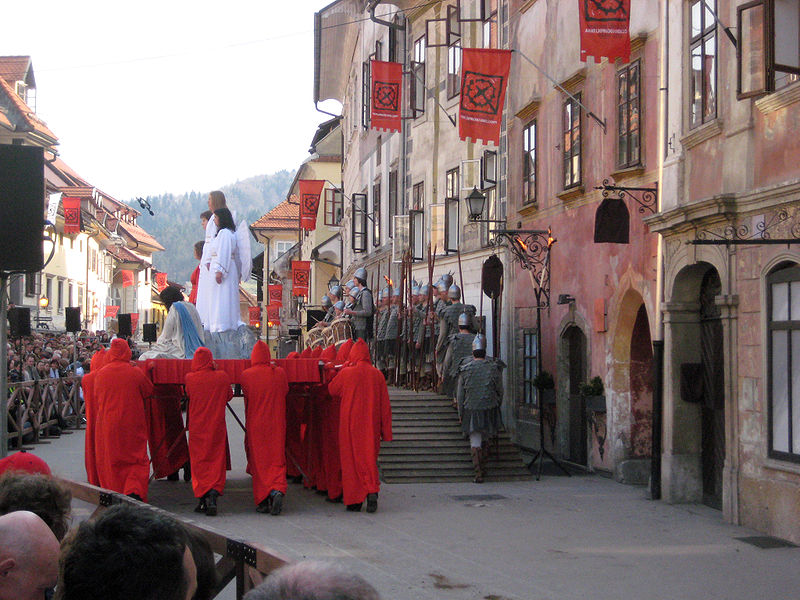
In 1715 a Lutheran pastor called Ferenc (Franc) #Temlin published 'Mali Katechismus' (Small Catechism).
It was the first book written in the #Prekmurje dialect, the easternmost #dialect of #Slovene, spoken in present-day eastern #Slovenia and in part of western #Hungary.
It was the first book written in the #Prekmurje dialect, the easternmost #dialect of #Slovene, spoken in present-day eastern #Slovenia and in part of western #Hungary.

Father Rogerij Ljubljanski (1667–1728) was a monk from #Ljubljana who employed patterns of classical rhetoric in his Baroque-style sermons. He recorded them in 'Palmarium Empyreum', written in #Slovene, #Latin, and #German. 

Jernej Basar was a Catholic priest from Škofja Loka. His 1734 collection of sermons uses the literary form of #Slovene, with some additional elements specific to his native #UpperCarniola #dialect. 

Miha Frančišek Paglovec also used an Upper Carniolan #dialect in his #Slovene works, including his 1741 'Evangelia inu Brania', parts of which he translated from Latin. It contains poems, prayers, and instructions for priests on topics like emergency baptism and Last Rites. 

Marko #Pohlin (1735–1801) was a writer, #linguist, and a promoter of the Slovene #language.
His books included 'Kraynska grammatika' (Carniolan Grammar), in which he attempted to modernise Adam #Bohorič's earlier grammar, and a #Slovene–#German–#Latin #dictionary.
His books included 'Kraynska grammatika' (Carniolan Grammar), in which he attempted to modernise Adam #Bohorič's earlier grammar, and a #Slovene–#German–#Latin #dictionary.
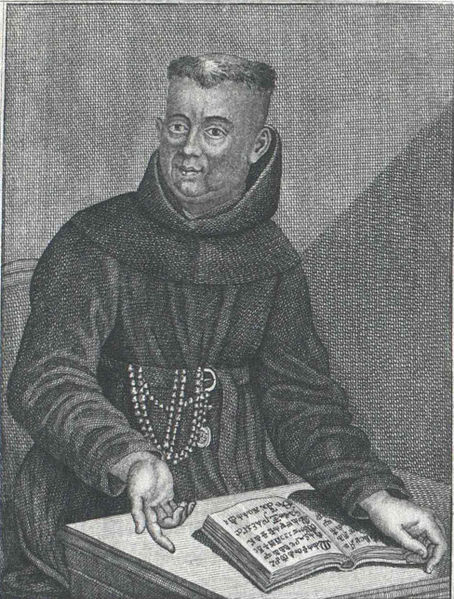
Jesuit priest Ožbalt Gutsman published 'Windische Sprachlehre' (Slovene Grammar) in 1777, and 'Deutsch–windisches Wörterbuch' (#German–Slovene Dictionary) in 1789. Both of these meticulous works are based on the #Carinthian #dialect of #Slovene.
A page from the #dictionary:
A page from the #dictionary:

Whereas previous histories of Slovene-speaking people had focused on one historical province or another, Anton Tomaž Linhart's 1791 history was the first to treat all Slovenes as a unit, and the first to define #Slovene people as a distinct ethnic group among the #Slavic peoples. 
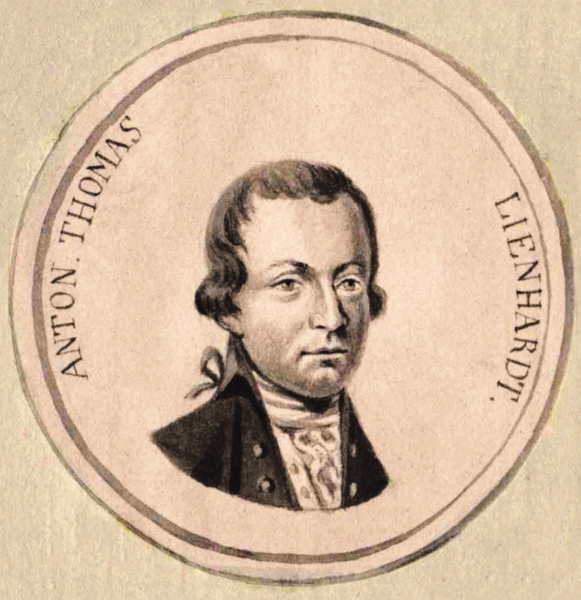
Anton Tomaž Linhart also published the first comedy and theatrical play in the #Slovene #language. In 1790 he translated and adapted 'Die Feldmühle' (The Country Mill), a 1777 German play by Joseph Richter, and renamed it 'Županova Micka' (Micka, the Mayor's Daughter). 

Valentin Vodnik (1758–1819) was a priest, poet, teacher, #linguist, and the editor of the first #Slovenian newspaper. He fervently advocated for the use of the Slovene #language in writing and education.
In 1799 he wrote 'Kuharske Bukve', the first #Slovene cookery book.
In 1799 he wrote 'Kuharske Bukve', the first #Slovene cookery book.

Valentin Vodnik published 'Lublanske novice' (#Ljubljana News) from 1797 to 1800. It was the first newspaper in the #Slovene #language. 

In 1808 #linguist Jernej #Kopitar published a scientific grammar of #Slovene titled 'Grammar of the #Slavic #Language in Carniola, Carinthia and Styria'.
He later advocated radical reform of the #Bohorič #alphabet, and influenced Vuk #Karadžić's reform of #Serbian #orthography.
He later advocated radical reform of the #Bohorič #alphabet, and influenced Vuk #Karadžić's reform of #Serbian #orthography.

'Theoretisch-praktische Windische Sprachlehre' is a grammar guide and #dictionary to help #German-speakers learn the #Slovene #language. It was written in 1812 by a lawyer called Janez Krstnik Leopold #Šmigoc. 
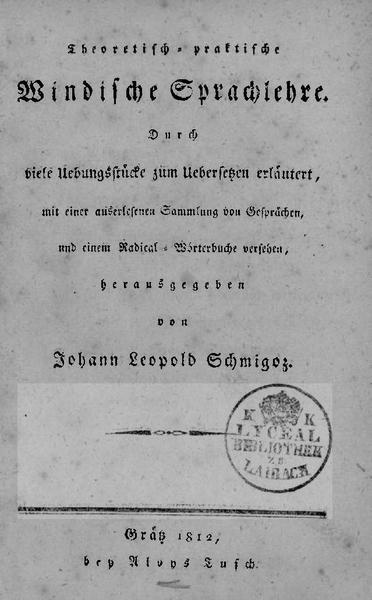
Peter #Dajnko was a priest and beekeeper from the village of Črešnjevci, which today lies in northeastern #Slovenia. In 1831 he wrote 'Čelarstvo', the first Slovene book about beekeeping (pictured).
However, he's better known for his earlier work in #Slovene #linguistics.
However, he's better known for his earlier work in #Slovene #linguistics.

In 1824, Dajnko wrote a book in German titled 'Textbook of the Slovene #Language'.
Instead of the #Bohorič alphabet, he promoted his own, later called the #Dajnko #alphabet (#dajnčica in #Slovene), using the letters C, S, and Z to represent the /ts/, /s/, and /z/ #phonemes.
Instead of the #Bohorič alphabet, he promoted his own, later called the #Dajnko #alphabet (#dajnčica in #Slovene), using the letters C, S, and Z to represent the /ts/, /s/, and /z/ #phonemes.

Peter Dajnko developed his writing system to maintain a one-to-one correspondence between letters and the #phonemes used in #Slovene.
A fragment of #Dajnko's 1827 'Posvetne pesmi' (Secular Songs), printed in the Dajnko #alphabet:
A fragment of #Dajnko's 1827 'Posvetne pesmi' (Secular Songs), printed in the Dajnko #alphabet:
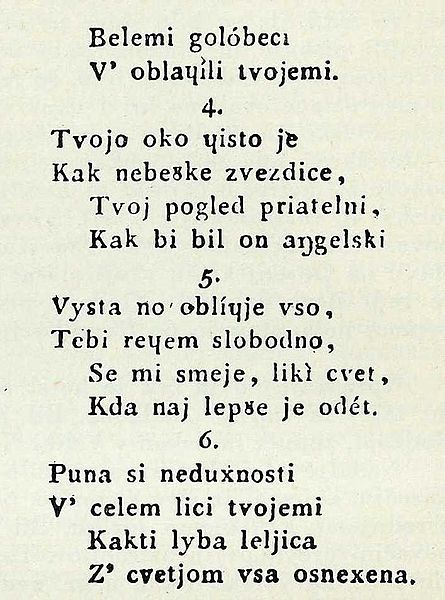
Just like #Dajnko, Franc Serafin Metelko was a priest and #linguist who wrote a German textbook about the Slovene #language.
Like Dajnko's 1824 work, Metelko's 1825 book proposed its own new writing system for #Slovene, known as the #Metelko #alphabet (#metelčica in Slovene).
Like Dajnko's 1824 work, Metelko's 1825 book proposed its own new writing system for #Slovene, known as the #Metelko #alphabet (#metelčica in Slovene).
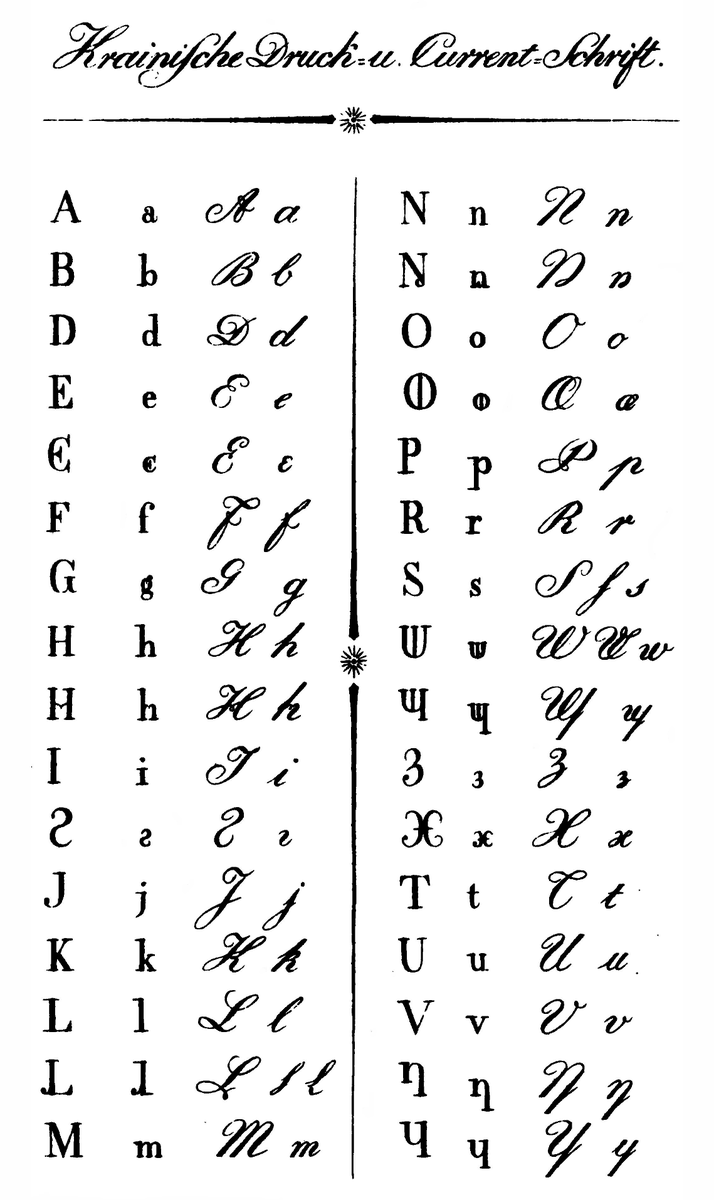
#Metelko created his 32-letter #alphabet to fix the problems that Jernej #Kopitar saw in the #Bohorič alphabet. He replaced digraphs, like ZH, with new letters, such as Ɥ (based on #Cyrillic Ч). He added vowels to distinctly represent more of the vowel sounds found in #Slovene. 

A debate called the '#Slovene alphabet war' divided scholars in the 1830s. By 1834, the #Bohorič alphabet had mostly fended off the challenge by the upstart #Dajnko and #Metelko #alphabets, only to be replaced in 1839 by a version of #Gaj's Latin alphabet.
https://twitter.com/linglore/status/1334240710418108418
Today's Slovene alphabet is a slight modification of #Gaj's Latin #alphabet. It has 25 letters:
A, B, C, Č, D, E, F, G, H, I, J, K, L, M, N, O, P, R, S, Š, T, U, V, Z, and Ž
The additional letters Ć, Đ, Q, W, X, and Y are sometimes used to spell non-#Slovene words and names.
A, B, C, Č, D, E, F, G, H, I, J, K, L, M, N, O, P, R, S, Š, T, U, V, Z, and Ž
The additional letters Ć, Đ, Q, W, X, and Y are sometimes used to spell non-#Slovene words and names.

Urban #Jarnik (1784–1844) was a priest, #linguist, historian, and ethnographer from #Carinthia. He extensively studied Slovene #dialects.
In 1832 he published a #Slovene etymological #dictionary, written in German.
In 1832 he published a #Slovene etymological #dictionary, written in German.

France Prešeren (1800–1849), a Romantic-period poet born in Upper #Carniola, is widely considered to be one of the great European Romanticists and a leading figure of #Slovene #literature.
His 1833 collection 'A Wreath of Sonnets' influenced other poets throughout Europe.
His 1833 collection 'A Wreath of Sonnets' influenced other poets throughout Europe.
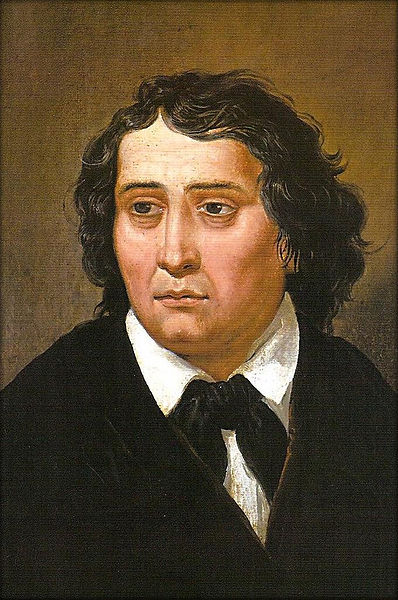
The ideals of the French Revolution inspired France #Prešeren's 1844 poem #Zdravljica. Many #Slovenes interpreted the poem as an appeal for #Slovene independence from the Habsburg Empire. A 1905 musical rendition of it became #Slovenia's national anthem in 1994. 

France #Prešeren's former classmate, Anton Martin #Slomšek (1800–1862), was a poet, singer, teacher, author, and an ardent proponent of teaching and writing in the #Slovene #language. He became a bishop in 1846. 

#Slomšek deeply influenced one of his students, Matija Majar, who also advocated teaching in Slovene.
In an 1848 article titled 'What do we Slovenes demand?', #Majar called for #Slovene lands to be unified. This manifesto sparked the formation of the United Slovenia movement.
In an 1848 article titled 'What do we Slovenes demand?', #Majar called for #Slovene lands to be unified. This manifesto sparked the formation of the United Slovenia movement.

The United Slovenia movement of the mid 19th century called for equal rights of the #Slovene #language in public.
This political movement brought the name #Slovenia (#Slovenija) into common usage. Before the 1840s, writers used the term 'Slovene lands'.
This political movement brought the name #Slovenia (#Slovenija) into common usage. Before the 1840s, writers used the term 'Slovene lands'.
https://twitter.com/linglore/status/1394346997134643202
Franz #Miklosich (Franc #Miklošič) abandoned his pursuit of a law career and instead became a leading expert in #Slavic #languages. He also wrote about #Romani, #Greek, #Albanian, #Romanian, and #Aromanian.
In 1848 he helped to shape the United #Slovenia political movement.
In 1848 he helped to shape the United #Slovenia political movement.

#Linguist Anton Janežič was Franz #Miklosich's student.
#Janežič taught Slovene and German, founded a Slovene literary magazine, and compiled a German–Slovene #dictionary.
In 1854 he published a #Slovene grammar book that was used in Slovene-#language schools until the 1920s.
#Janežič taught Slovene and German, founded a Slovene literary magazine, and compiled a German–Slovene #dictionary.
In 1854 he published a #Slovene grammar book that was used in Slovene-#language schools until the 1920s.
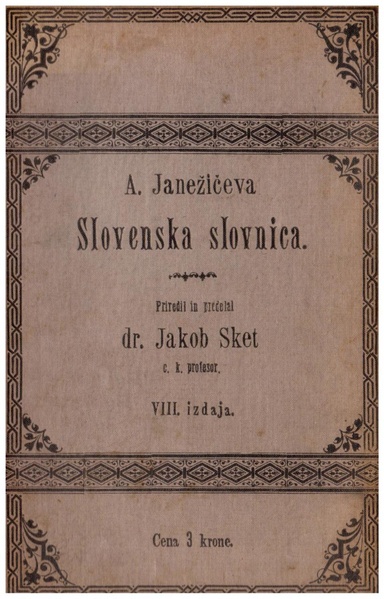
Josipina Toman (née #Urbančič) (1833–1854) was one of the first female Slovene writers and composers. She used the pen name Josipina #Turnograjska, after Turn Castle, her home in Upper Carniola.
Writing only in #Slovene, she drew her material from #Slavic history and legends.
Writing only in #Slovene, she drew her material from #Slavic history and legends.

Fran Levstik was a Slovene writer, #linguist, and political activist.
In his 1858 essay 'Errors of Slovene Writing', #Levstik criticised literary conventions used by #Slovene writers, arguing that the written #language should more closely reflect the way Slovenes commonly speak.
In his 1858 essay 'Errors of Slovene Writing', #Levstik criticised literary conventions used by #Slovene writers, arguing that the written #language should more closely reflect the way Slovenes commonly speak.
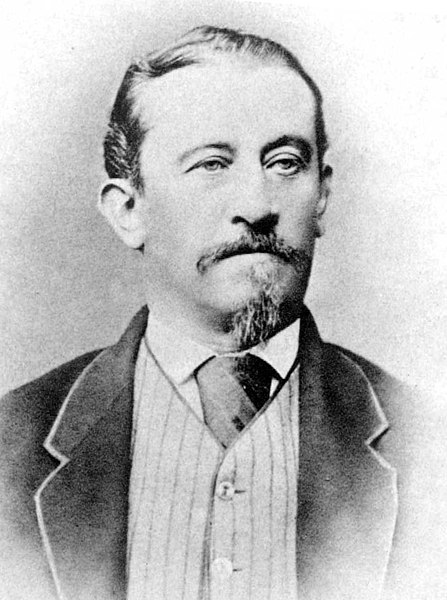
Andrej #Praprotnik (1827–1895) was a writer, translator, editor, and primary school teacher. He promoted the practice of teaching #Slovene children in their own language, often encountering opposition from those who sought to preserve German's status as the #language of prestige. 

Anton #Breznik, a #linguist, priest, and educator, published 'Slovene Grammar for Secondary Schools' in 1916.
He also published works on #Slovene #orthography, and contributed to a Greek–Slovene dictionary.
He also published works on #Slovene #orthography, and contributed to a Greek–Slovene dictionary.
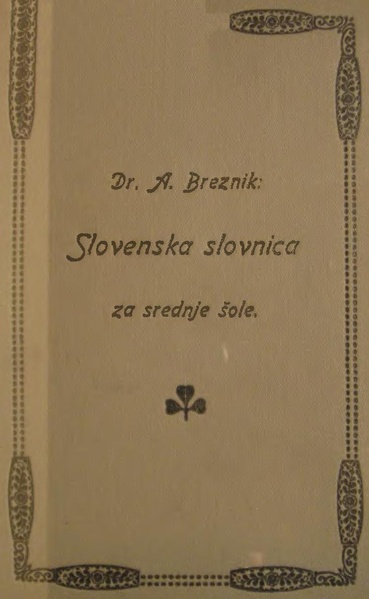
Marica #Nadlišek Bartol was a writer, teacher, and feminist activist from #Trieste. After Italy annexed her city at the end of WWI, she continued to teach #Slovene in secret. She was repeatedly interrogated by the Carabinieri, and was eventually forced to move to Ljubljana. 

The #Slovene #language was banned in Carinthia after the #Anschluss of 1938. Its use in #Carinthia dropped from 21% (in a 1910 census) to below 10% by 1951. (The figure is below 3% today.)
Adolf Hitler and Heinrich Himmler in #Klagenfurt in 1938:
[Image: commons.wikimedia.org/wiki/File:Bund…]
Adolf Hitler and Heinrich Himmler in #Klagenfurt in 1938:
[Image: commons.wikimedia.org/wiki/File:Bund…]

Despite its preponderance of #SerboCroatian speakers, Communist #Yugoslavia had no official #language at the federal level.
Among the country's six constituent units, only the Socialist Republic of #Slovenia had a #Slovene-speaking majority.
[Image: en.wikipedia.org/wiki/File:Loca…]
Among the country's six constituent units, only the Socialist Republic of #Slovenia had a #Slovene-speaking majority.
[Image: en.wikipedia.org/wiki/File:Loca…]

Lt Gen Jaka Avšič secured a promise from Marshal Tito that Slovene soldiers in #Yugoslavia's Communist forces could use Slovene. The promise wasn't kept. In a 1967 essay 'For the Equality of the #Slovenian #Language', #Avšič documented how #Slovene was disregarded by authorities. 

Slovenia gained independence from #Yugoslavia in 1991.
Its official #language, #Slovene, became one of the European Union's official #languages in 2004 when #Slovenia joined the #EU.
Its official #language, #Slovene, became one of the European Union's official #languages in 2004 when #Slovenia joined the #EU.

The main regional groups of #Slovene #dialects are:
Upper #Carniolan (dark green)
Lower Carniolan (light green)
#Styrian (orange)
#Pannonian (yellow)
#Carinthian (red)
#Littoral (blue)
#Rovte (purple)
Mutual intelligibility between some #dialect groups is limited.
Upper #Carniolan (dark green)
Lower Carniolan (light green)
#Styrian (orange)
#Pannonian (yellow)
#Carinthian (red)
#Littoral (blue)
#Rovte (purple)
Mutual intelligibility between some #dialect groups is limited.

The standard variety of #Slovene formed in the 18th and 19th centuries, based on a blend of the Upper and Lower #Carniolan #dialects spoken in the Ljubljana area.
An 18th-century painting of #Ljubljana:
An 18th-century painting of #Ljubljana:

The #Kostel dialect of southern #Slovenia belongs to the #LowerCarniolan dialect group. Features of the #dialect extend into the Gorski Kotar region of Croatia, where #Slovenes from #Carniola settled in the 17th and 18th centuries.
Lake #Lokve in #GorskiKotar, #Croatia:
Lake #Lokve in #GorskiKotar, #Croatia:

The #Kočevje region in #Slovenia used to be a German-speaking region called Gottschee. Germany forcibly relocated most of the #Gottschee Germans during WWII.
Slovenes from various areas then resettled the region, creating a mixed-dialect area distinct from the rest of #Carniola.
Slovenes from various areas then resettled the region, creating a mixed-dialect area distinct from the rest of #Carniola.

Akanje or akanye (literally 'a-ing') is a form of vowel reduction in which some vowels merge into [a]. It's found in several #Slavic #languages and dialects, including some #Slovene dialects. The Cerkno dialect in the #Rovte #dialect group features #akanje.
#Cerkno in #Slovenia:
#Cerkno in #Slovenia:

Čičarija is a region of Slovenia in the northeastern part of the #Istrian Peninsula, close to #Croatia.
The Čičarija dialect combines #Slovene's Littoral dialect group (such as the Inner #Carniolan #dialect) with #Croatian #Chakavian.
A 1955 photo near #Obrov in #Čičarija:
The Čičarija dialect combines #Slovene's Littoral dialect group (such as the Inner #Carniolan #dialect) with #Croatian #Chakavian.
A 1955 photo near #Obrov in #Čičarija:
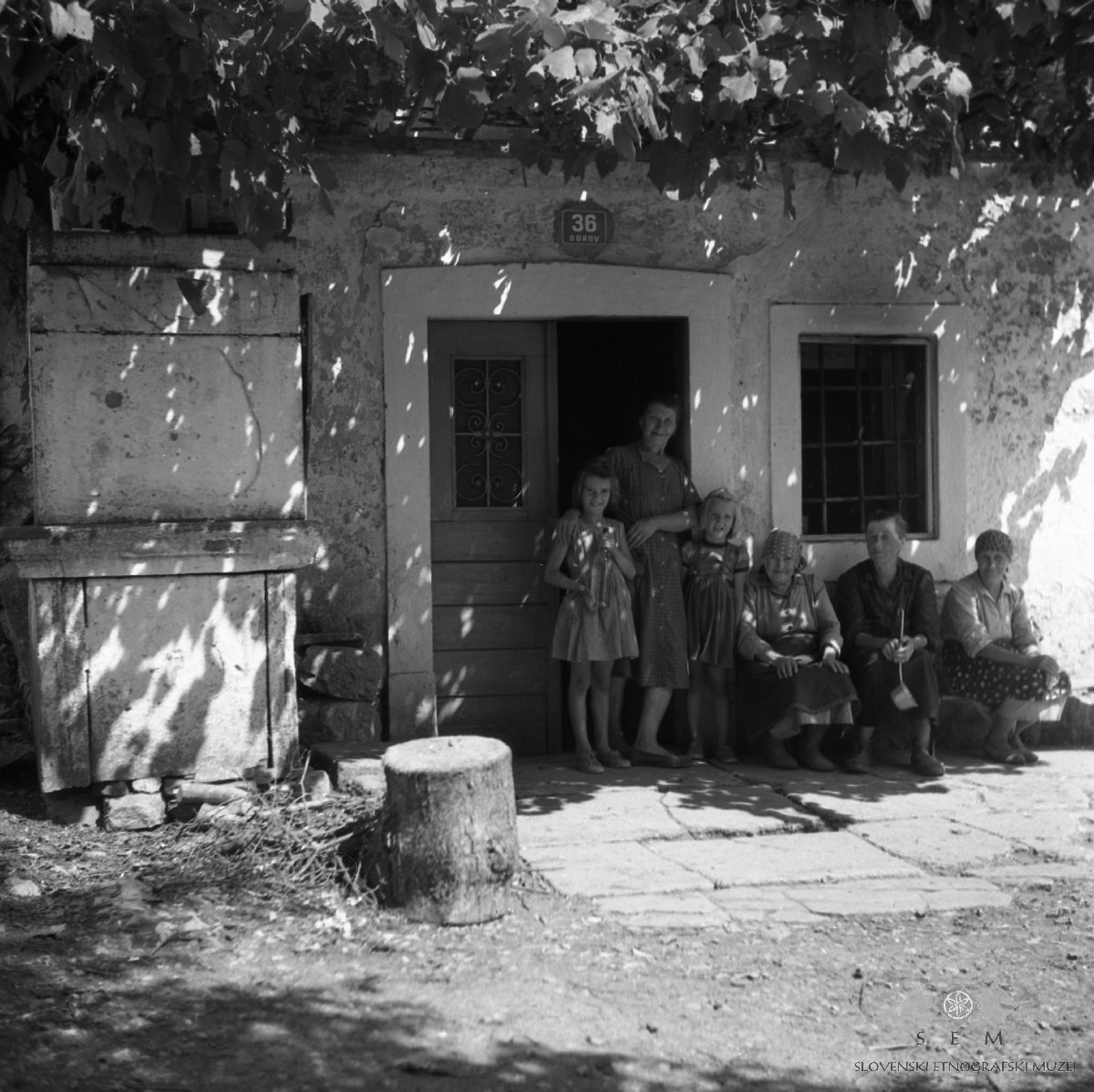
The Istrian dialect's #Šavrin Hills subdialect belongs to the Littoral group of #Slovene dialects, but also has elements of Lower Carniolan dialects, Romance #languages, and #SerboCroatian dialects spoken by Uskok soldiers who settled in #Istria in the 16th and 17th centuries. 

Around 52K to 100K speakers of the Littoral dialect group of Slovene live in northeastern #Italy, close to the border with #Slovenia.
#Slovene is used in education and has official status in several municipalities.
[Image: en.wikipedia.org/wiki/File:Post…]
#Slovene is used in education and has official status in several municipalities.
[Image: en.wikipedia.org/wiki/File:Post…]

The Karst #dialect of Slovene is spoken in western #Slovenia, and eastern #Italy near #Trieste and #Gorizia, including parts of the #Prosecco area, home of the famous sparkling wine.
'Prosecco' comes from the #Karst #Slovene word 'prosek', meaning 'path cut through the woods'.
'Prosecco' comes from the #Karst #Slovene word 'prosek', meaning 'path cut through the woods'.

The endangered Torre Valley dialect, in the Littoral group, is #Slovene's westernmost dialect. It's spoken in #Breginj, #Slovenia, and in #Lusevera (pictured) and #Taipana, #Italy. The #dialect borrows words from German, Friuli, and Italian.
[Image: commons.wikimedia.org/wiki/File:Luse…]
[Image: commons.wikimedia.org/wiki/File:Luse…]

The Resian #dialect of #Slovene is spoken in the #Resia Valley in #Italy. Many of its speakers consider it a separate language. (Linguists disagree.)
Resian uses the letter W, which is otherwise not used by any of the South #Slavic #languages.
The Lord's Prayer in old #Resian:
Resian uses the letter W, which is otherwise not used by any of the South #Slavic #languages.
The Lord's Prayer in old #Resian:

Speakers of Slovene's Gail Valley dialect live in three countries: #Slovenia, #Austria, and Italy. It's part of the #Carinthian dialect group.
#Feistritz an der Gail (#Slovene: Bistrica na Zilji) is one of the towns in Austria where it's spoken:
[Image: en.wikipedia.org/wiki/File:2021…]
#Feistritz an der Gail (#Slovene: Bistrica na Zilji) is one of the towns in Austria where it's spoken:
[Image: en.wikipedia.org/wiki/File:2021…]
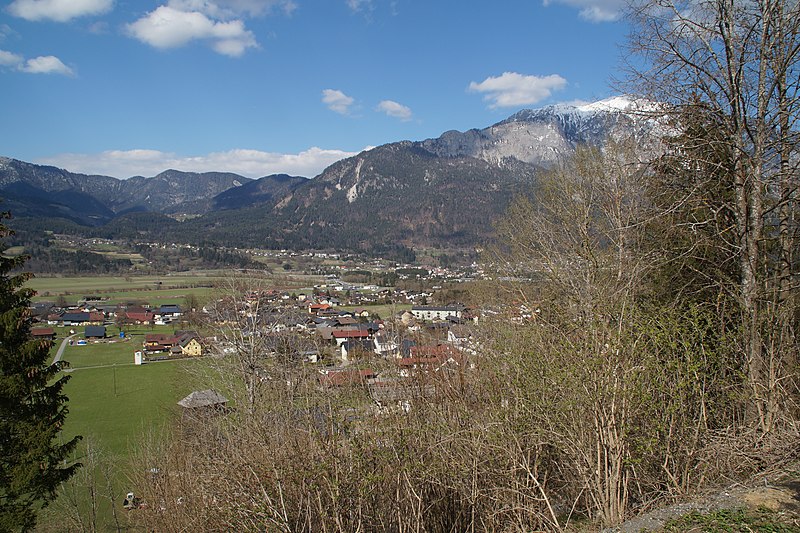
The Prekmurje dialect of #Slovene belongs to the Pannonian dialect group. It has an estimated 110,000 speakers worldwide, most of whom live in the Prekmurje region in northeastern #Slovenia. Many of the 5,000 Slovenes in #Hungary also speak the dialect.
A 1786 #Prekmurje primer:
A 1786 #Prekmurje primer:

Since the late 19th century, the US city of #Cleveland, #Ohio has been home to the largest #Slovene community outside Europe. The population has gradually shifted to English. The last Slovene-#language newspaper there ceased publication in 2008.
[Image: flickr.com/photos/timevan…]
[Image: flickr.com/photos/timevan…]

#Yugoslav Braille is a #braille #alphabet used to write the Macedonian, #SerboCroatian, and Slovene #languages.
The #Croatian, #Serbian, #Slovene, and #Macedonian varieties of #YugoslavBraille differ slightly in how they represent punctuation.
The #Croatian, #Serbian, #Slovene, and #Macedonian varieties of #YugoslavBraille differ slightly in how they represent punctuation.

#YugoslavSignLanguage is used in the countries of the former #Yugoslavia.
Most of its users use their nation's variety of the two-handed #YugoslavManualAlphabet, based on either #Cyrillic (Macedonian shown below) or Gaj's Latin Alphabet.
[Image: mk.wikipedia.org/wiki/%D0%9F%D0…]
Most of its users use their nation's variety of the two-handed #YugoslavManualAlphabet, based on either #Cyrillic (Macedonian shown below) or Gaj's Latin Alphabet.
[Image: mk.wikipedia.org/wiki/%D0%9F%D0…]
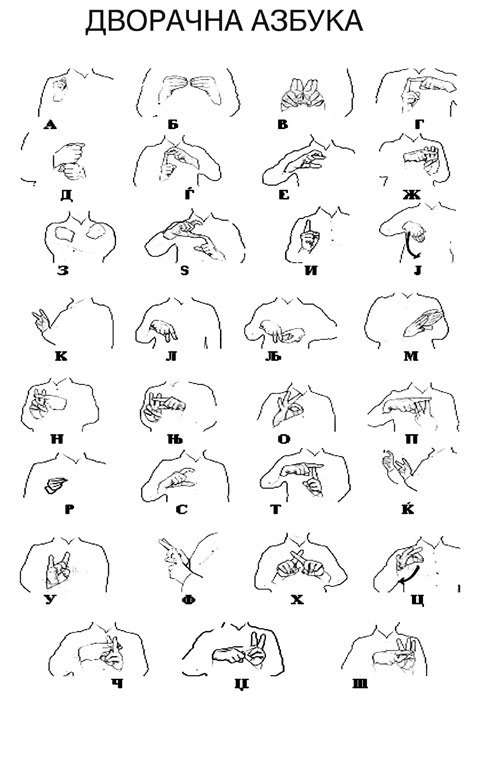
The #BalkanSprachbund refers to a set of linguistic features (e.g. similar grammar) that are shared across Balkan #languages that have very different origins, including Albanian, Romani, Greek, Turkish, Romanian, and the South #Slavic languages.
1918 map of the Balkan Peninsula:
1918 map of the Balkan Peninsula:

The #Slavic #languages are conventionally categorised into three main branches: South, West, and East.
A few scholars reject this convention, judging West and East too similar and intertwined to justify distinct branches. They recognise just two main branches: North and South.
A few scholars reject this convention, judging West and East too similar and intertwined to justify distinct branches. They recognise just two main branches: North and South.

The #languages that are conventionally classified in the West #Slavic branch are spoken mainly in #Poland, #Czechia, and #Slovakia, with small pockets of speakers in other European countries, especially Germany, Belarus, and Lithuania.
[Image: en.wikipedia.org/wiki/File:Leng…]
[Image: en.wikipedia.org/wiki/File:Leng…]

East Slavic languages are spoken in mainly Orthodox areas and are usually written using #Cyrillic.
The areas where West #Slavic #languages are spoken are historically Roman Catholic or Protestant. These languages use the Latin script.
A memorial plaque in Russian and Czech:
The areas where West #Slavic #languages are spoken are historically Roman Catholic or Protestant. These languages use the Latin script.
A memorial plaque in Russian and Czech:

The West #Slavic #languages have roughly sixty million native speakers and are usually divided into three groups:
• Czech-Slovak (yellow on map), mainly in Czechia and Slovakia
• Sorbian (pink), in Germany
• Lechitic (green), mainly in Poland
[Image: en.wikipedia.org/wiki/File:Zapa…]
• Czech-Slovak (yellow on map), mainly in Czechia and Slovakia
• Sorbian (pink), in Germany
• Lechitic (green), mainly in Poland
[Image: en.wikipedia.org/wiki/File:Zapa…]

The Czech and Slovak #languages descended from the Common #Slavic language spoken by #Czech, #Moravian, and #Slovak tribes.
In the 7th century the Frankish ruler Samo united Czechs and Moravians (and possibly Slovaks) with other Slavs to counter attacks by the Pannonian Avars.
In the 7th century the Frankish ruler Samo united Czechs and Moravians (and possibly Slovaks) with other Slavs to counter attacks by the Pannonian Avars.

In the 9th century, some of the earliest West #Slavic polities were founded along two tributaries of the Danube, the Nitra and the #Morava.
The Principality of Moravia then annexed the Principality of #Nitra and expanded to form Great #Moravia, the first major West Slavic state.
The Principality of Moravia then annexed the Principality of #Nitra and expanded to form Great #Moravia, the first major West Slavic state.

Slavs in Great #Moravia welcomed linguistic influence from other #Slavic lands. #Cyril and #Methodius successfully introduced #OldChurchSlavonic and the #Glagolitic alphabet — until the Church banned them in 880 in favour of the Latin script and liturgy.
https://twitter.com/linglore/status/1216008655163793408
#Czech and Slovak began to diverge from other West #Slavic #languages (and from each other) around the 10th century.
Some of the earliest records of pre-#Slovak words and names are found in Latin documents, such as the 9th–10th century Gospel of Cividale.
Some of the earliest records of pre-#Slovak words and names are found in Latin documents, such as the 9th–10th century Gospel of Cividale.

• • •
Missing some Tweet in this thread? You can try to
force a refresh


